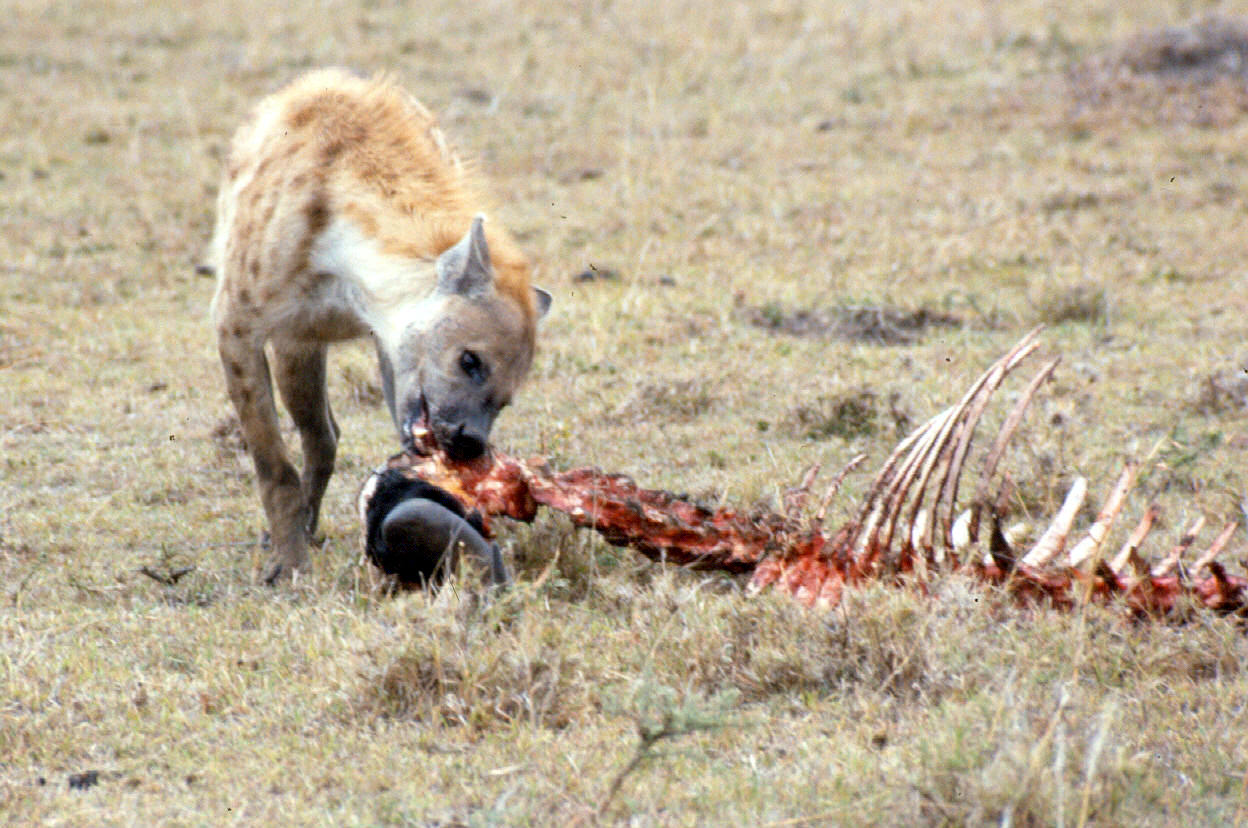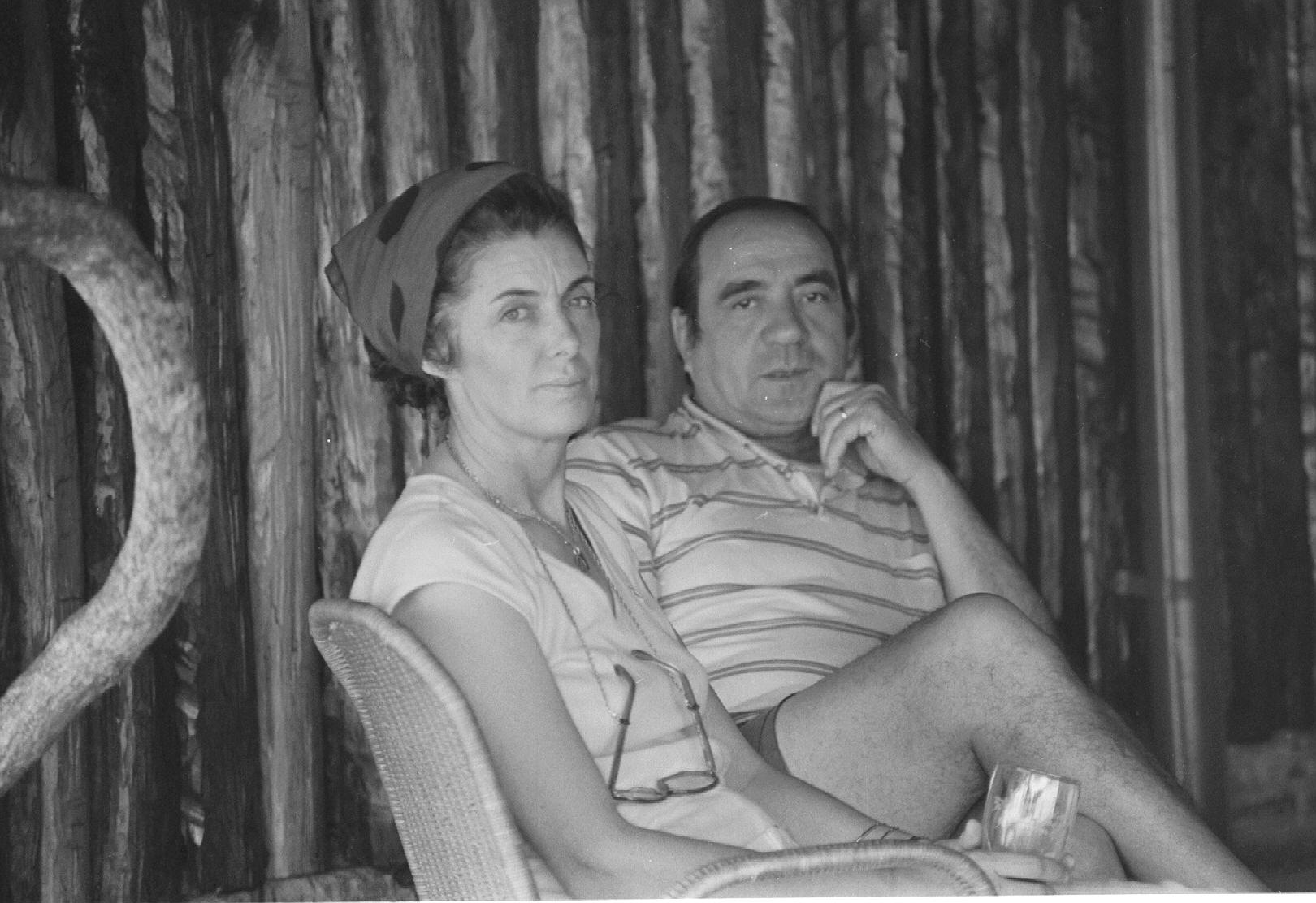Kenya and Tanzania – February 1988
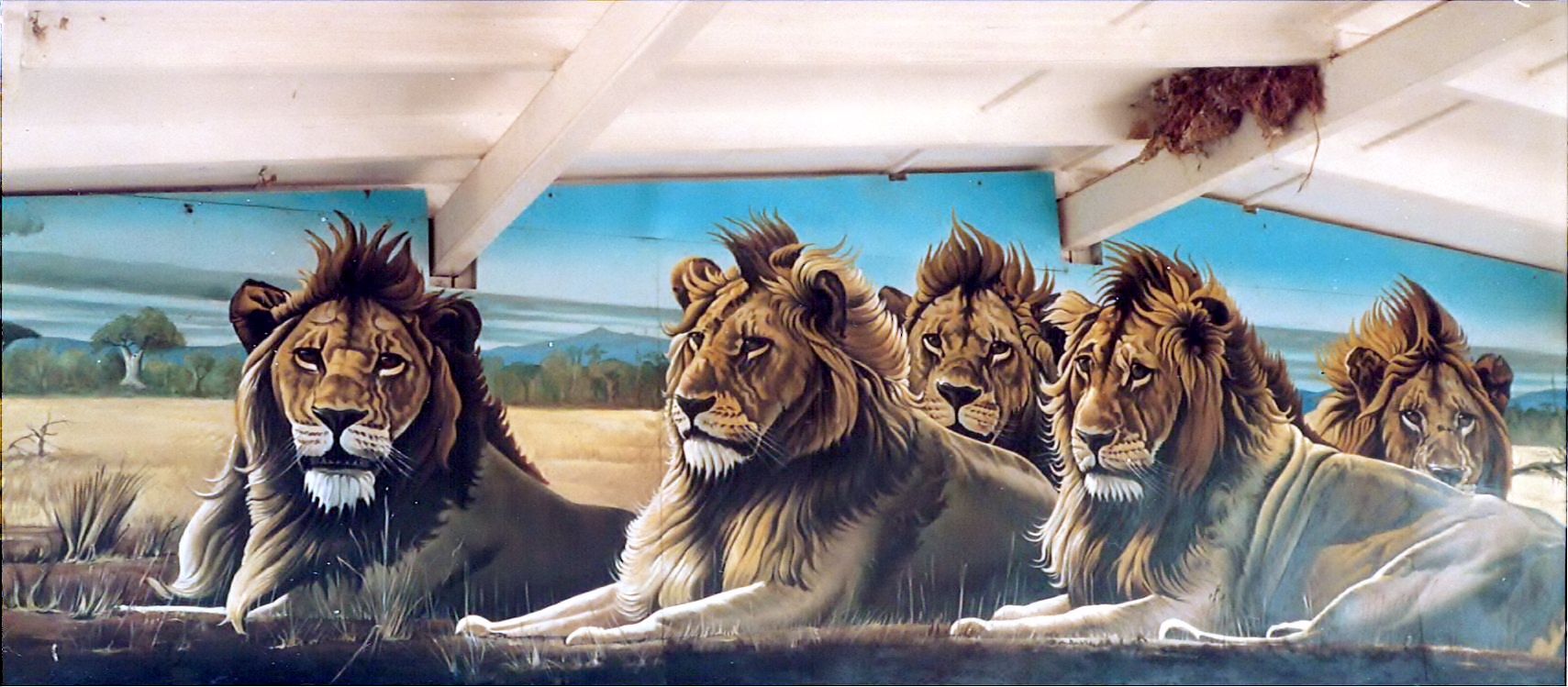 Beautiful and promising wall-painting in a petrol station at the Kenya-Tanzania border!
Beautiful and promising wall-painting in a petrol station at the Kenya-Tanzania border!
The trip in a few words.
Itinerary
Nairobi City (Kenya) – Ngorongoro Crater (Tanzania) – Manyara Lake (Tanzania) – Nairobi City (Kenya)
Participants
[1] 4WD – driver; [2] Xray – wife and game spotter – in Land Rover; [3] ScoutSpirit – driver; [4] PinkShade – partner and story teller; [5] Khanga – mum of PinkShade – in Isuzu Trooper.
 The team getting ready, early in the morning, around the Land Rover (PinkShade missing)
The team getting ready, early in the morning, around the Land Rover (PinkShade missing)
The trip in detail.
Saturday, 20th of February – Towards the mythical crater – Getting in the mood and freezing!
In two cars, on a beautiful Saturday morning, we left Nairobi for Ngorongoro Crater and Lake Manyara. A light spirit invaded me as we set off. Initially nothing special to mention, except for the very good road conditions up to Namanga, on the border between Kenya and Tanzania.
After passing through the Kenyan and Tanzanian border posts we were on our way to Arusha. The landscape was quite green despite the dry-area type of vegetation. We tried to spot Mount Kilimanjaro and Mount Meru, but the clouds were totally hiding the mountains, not as usual just the top.
For lunch, we stopped in Arusha, briefly visited the Mount Meru Lodge, and refuelled. We eventually found ourselves on the road to Babati and Dodoma. It started to rain, so we rushed to Makuyuni on a zig-zag-track mixed with some parts of the old road – roadworks in progress!
Along that road we encountered some young Maasaï boys. They were dressed in black khangas over their shoulders and around their waists, their faces painted with white clay. Huge ostriches feathers were held on the back of their heads with headbands. They seemed to appear from nowhere, walking in small groups, an impressive and beautiful sight. I had never been lucky enough to see these young, newly circumcised boys in Kenya [6].
 A cultivated area on a wide plateau, before the entrance gate
A cultivated area on a wide plateau, before the entrance gate
At Makuyuni, we turned right, towards the lake and the crater. The traditional Maasai became scarce, and after the climbing above Manyara Lake we saw almost nobody, but that was the start of the collective cultivation: a vast plateau stretching out as far as the eye could see, all broken up into long and wide rectangular shapes. It might be a good thing for Tanzania, but it is a very disappointing landscape for those who wish to discover the wilderness.
We passed the entrance to Ngorongoro Conservation Area [7] and started the long climb to the rim of the crater, which peaks at something like 2,600 m. As we passed the gate we started drinking the usual mate [8]. From the viewpoint, the inside of the crater was striking and everybody was surprised as it somehow didn’t match what each of us had imagined. We all agreed that it was much better than our expectations, quite GORGEOUS in fact.
Friends had described the crater to me so, I expected it to be small, crowded, with animals standing shoulder to shoulder. I had been told that it was much like a zoo and that I might be disappointed. Thank God, it wasn’t like that at all! It was big but not too big, just the right size to be impressive, but still on a human scale! We spotted buffalos and some patches of other undetermined beasts, but they did not cover the whole crater floor like a wall-to-wall-carpet. We wanted to go down immediately to see it all from close, but, as it was late we chose instead to rush to the campsite because it was getting dark.
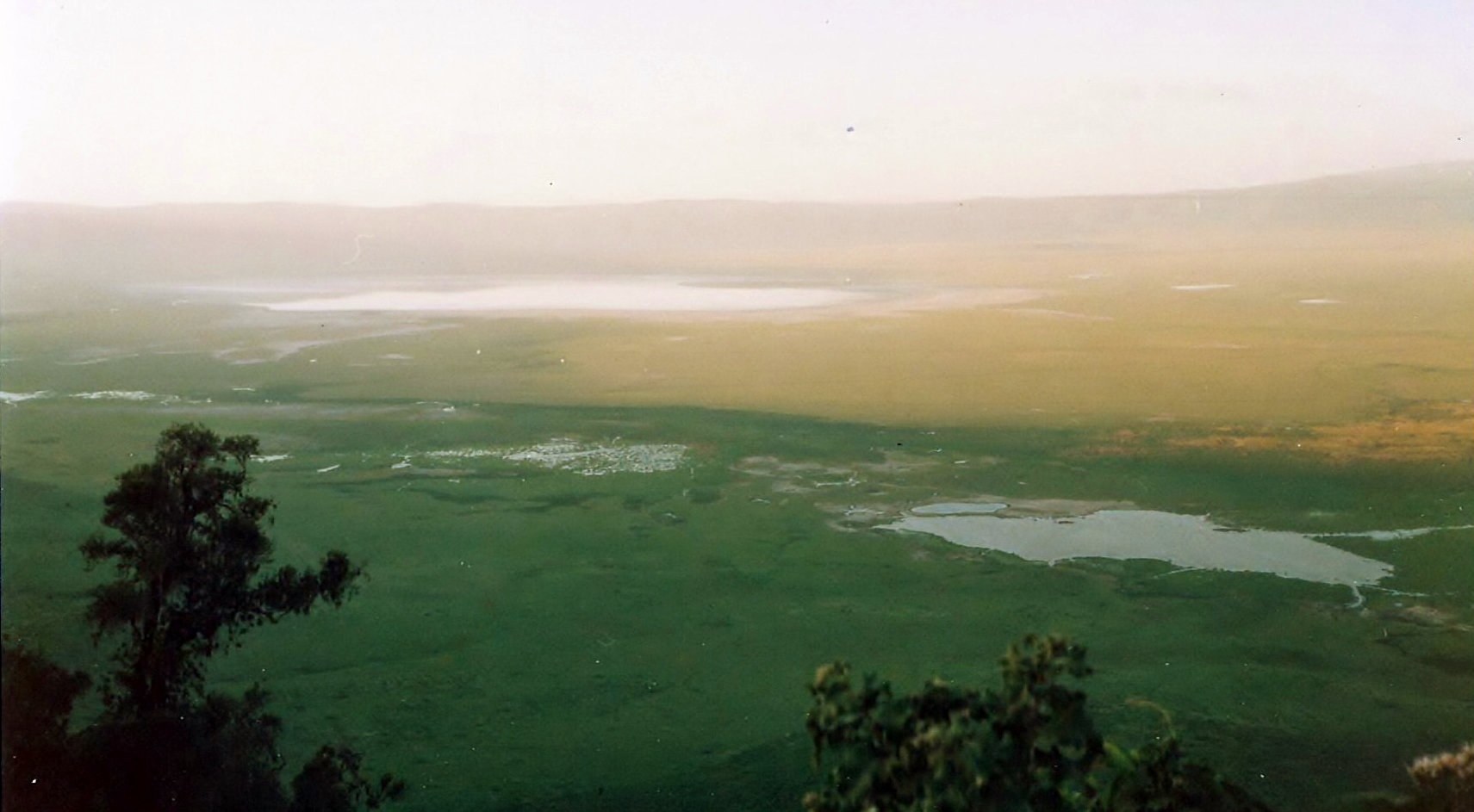 First view coming up the outer rim of the crater… almost at dusk
First view coming up the outer rim of the crater… almost at dusk
The “Simba” campsite wasn’t that easy to find. We spent one hour driving around the crater looking for it and arrived at 8 PM on the dot; the temperature was already freezing. There was a lot of soft and thick grass for our comfort, and a lot of cold and rough wind for our misery! We then forgot about it all, and after unloading the cars, we started to cook as soon as possible. Of course the gas-cooker wouldn’t stay alight with such a wind, so we settled it on the grass in between a few crates, to keep it away from the thick grass. After the meal, we felt warm again for about 10 minutes, but started to freeze again very soon. So we disappeared into our tents, and inside our sleeping-bags.
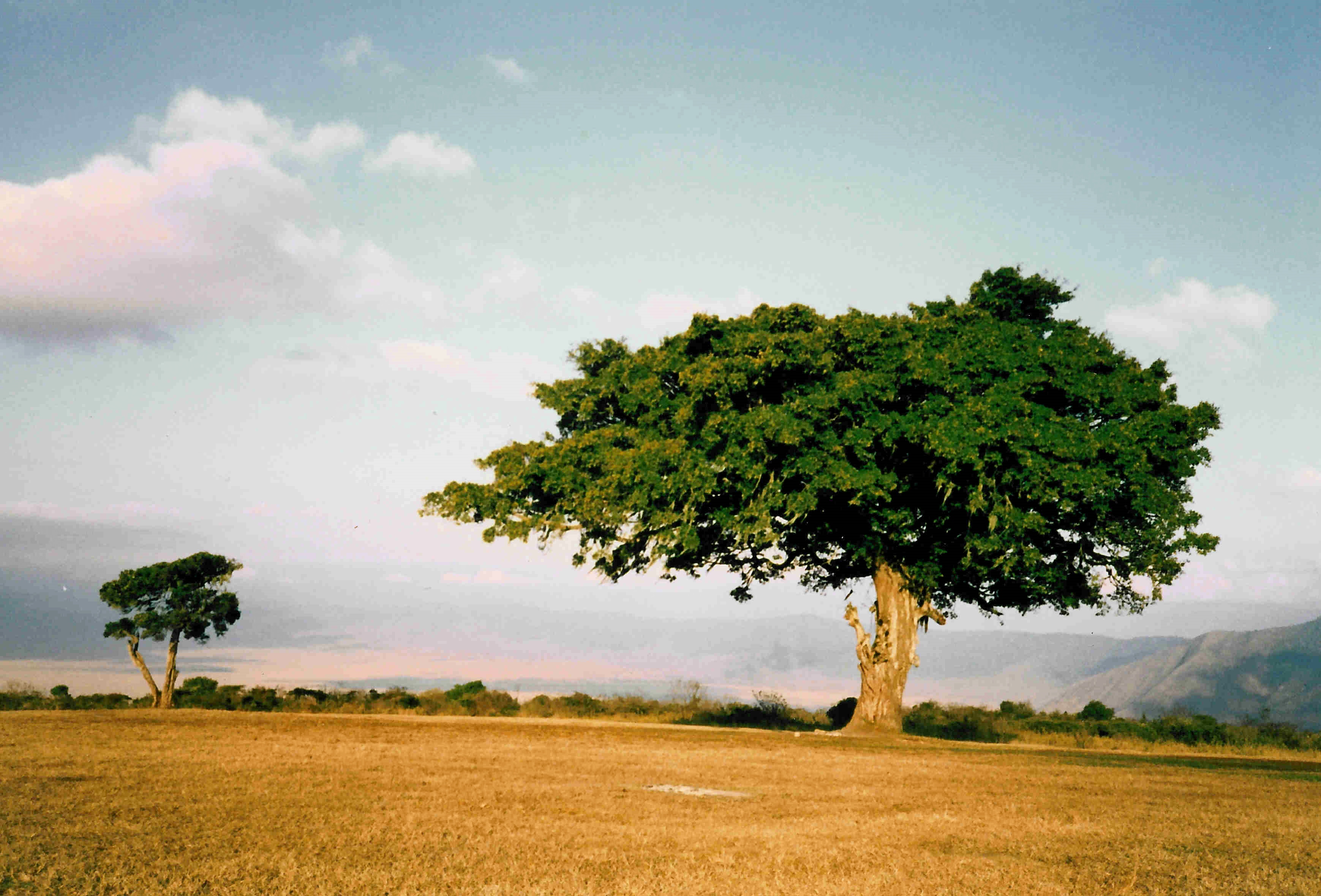 The Simba campsite as we discovered it on the next morning…
The Simba campsite as we discovered it on the next morning…
Sunday, 21st of February – Visiting the garden of Gods – Getting down the rim and enjoying!
I froze at the beginning of the night, Scout Spirit froze a tiny bit in the morning, and Khanga froze the whole night! X-Ray sweated the whole night and 4WD was apparently alright! I was told later that Khanga didn’t get the sleeping-bag that was meant for her. Obviously X-ray got it!
Anyway, the sun came up and heated our tents and surrounds, but three of us (no names!) stayed in their beds. That is why we were very late going down into the crater. Well, not only that, we also lost some time by having two punctures on the way out of the campsite. This brought us to the Park’s garage or workshop. We had to go there anyway to meet the warden and ask permission to go down without a guide.
 The pride of lions that 4WD and then Khanga spotted…
The pride of lions that 4WD and then Khanga spotted…
At 11 AM or so, we descended from the rim to the bottom of that old volcano and by the time 4WD stopped, he already had spotted ten lions! He didn’t tell us where just to tease us. And it took us nearly a quarter of an hour to find out what it was. Khanga spotted some funny beige things, many of them, and thanks to her we saw the lions that 4WD was talking about.
We also saw very far away a big black-maned lion walking across the plain. We watched him for some time, a very nice sight, in fact majestic. After a while, I realized that he looked quite thin and I wished we could have seen him better because I wasn’t sure that he was alright. We had with us a rough map of the crater, quickly drawn by the warden when we were at the office and we discovered that we could do a circuit. So we left for the North-East.
That itinerary gave us great pleasure as there were a lot of ponds along the track. This meant we saw many water birds and amongst them, a few of the famous Abdim’s storks. We saw three more male lions on the bank of a big pond, beautiful black-maned lions. We spotted a lot of Grant’s and Thompson’s gazelles, and zebras and wildebeest. As we wished to eat our picnic, we spotted a hill that we thought would provide us with a perfect view. On climbing the slope, we encountered the biggest herd of buffaloes we’ve ever seen. They were drinking around a waterhole, surrounded by hundreds of cattle-egrets, ibises and crowned-cranes.
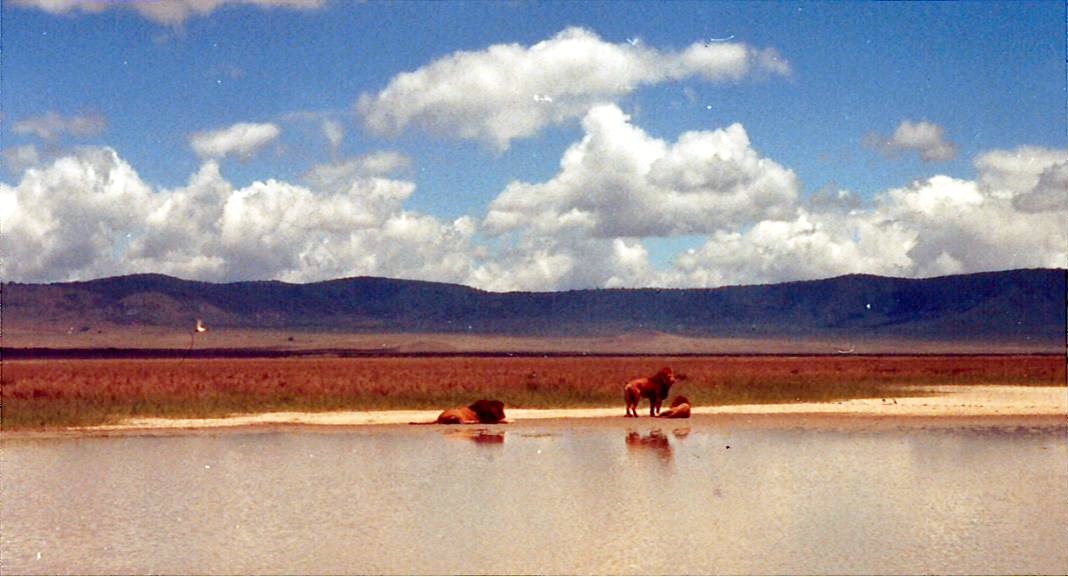 Three black-maned lions lying by a small pond
Three black-maned lions lying by a small pond
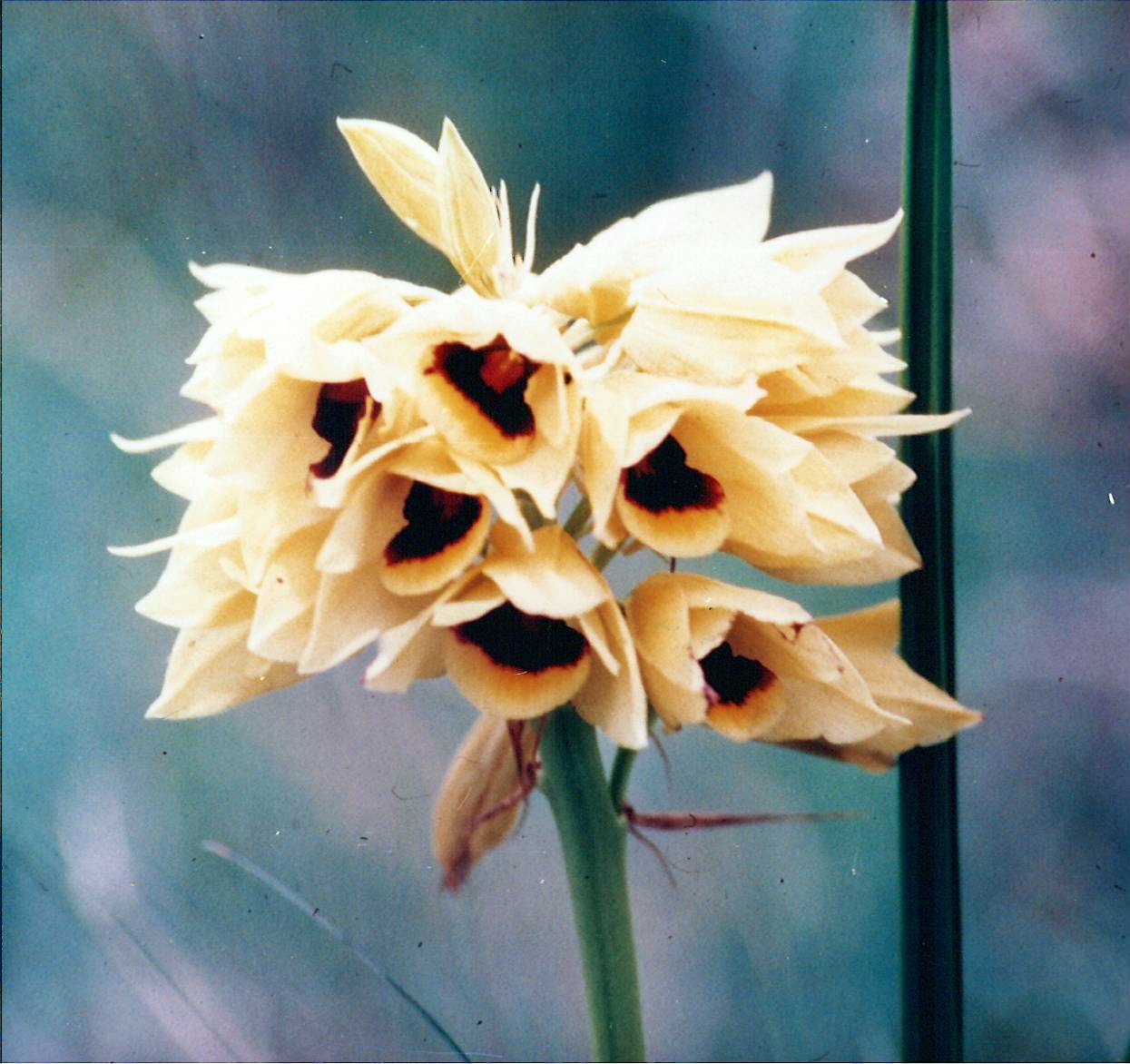 Yellow orchid found on the hill (4WD’s picture)
Yellow orchid found on the hill (4WD’s picture)

View of a big pond at the bottom of the crater
As we sat down, we noticed a male ostrich guiding his seven chicks along the foot of the hill. The buffalos had already finished drinking and moved off quickly. As 4WD threw his bone (from a chicken) away, a kite dived to fetch it, but missed! ScoutSpirit and 4WD played with him for a while, throwing the bone in the air again and again. After several misses, the kite managed and left, obviously exhausted, with the bone in his claws as a trophy. After that, we continued our game-drive around the top of the hill where we saw fantastic flowers such as red hibiscus and yellow orchids in the high grass. We reached a point where we had a view over the eastern side of the foothill, and a herd of elephants appeared, great! Not far from there, we came across another lion on a sandy shore and another elephant, standing alone in some low bushes. All that from that one hill. What a lucky and happy time!
From there we zigzagged between the shore of Lake Magadi and small tributaries where some spotted hyenas were lying and rolling in the mud, as disgraceful as usual! One golden jackal passed by and as we went East, and lost sight of 4WD’s Land Rover, we nearly drove over two sleeping rhinos. We waited there for 4WD and X-Ray to join us but they had spotted some maybe– cheetah, so they were waiting for us to come [9]! In the end, we all met up to watch the rhinos for a while.
A little bit further on were two more rhinos, and lots of wildebeest and eland. Scout Spirit thought that he spotted some tiny bat-eared foxes and Khanga pointed out two lion-cubs. We curved downwards to the West to join the track climbing out of the crater. The light was splendid, just GORGEOUS of course! I don’t know what was spotted and then lost, but the point is that we used this very stop to start the mate. Khanga became friends with a small Bustard. She could approach it so closely that she shot a picture with her 35 mm and it came out quite nicely. After that, we were able to get quite close to some hippos, another fantastic view.
In the late afternoon the lake and the mountains were covered by a gentle yellow light. There were plenty of water birds, mostly Egyptian geese and ibises. To the West, the yellow fever trees were also brightly illuminated and as we drove through them we met some elephants again. It was a pretty magical time! But while we were surrounded by magic we realized that some of our suspension leaf-springs were broken! We had to get to a garage so we started to climb up the rim very slowly, staring down at the crater, beautiful in the last sunrays. We went through a thick forest with lianas and then along a rocky track with wonderful flowers and plants on all sides.
 The famous bustard, good friend of Khanga!
The famous bustard, good friend of Khanga!
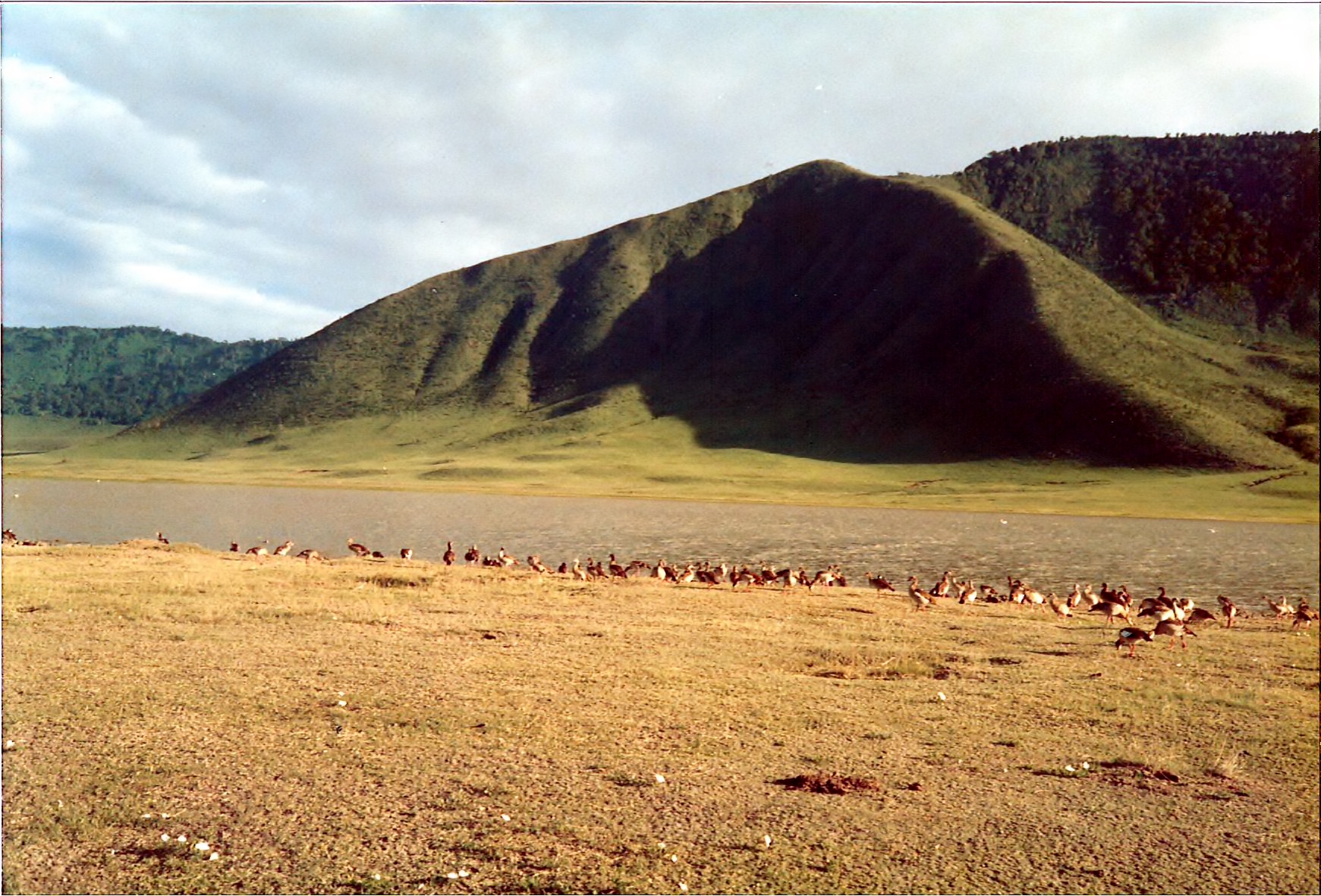 Egyptian geese feeding and resting near a pool
Egyptian geese feeding and resting near a pool
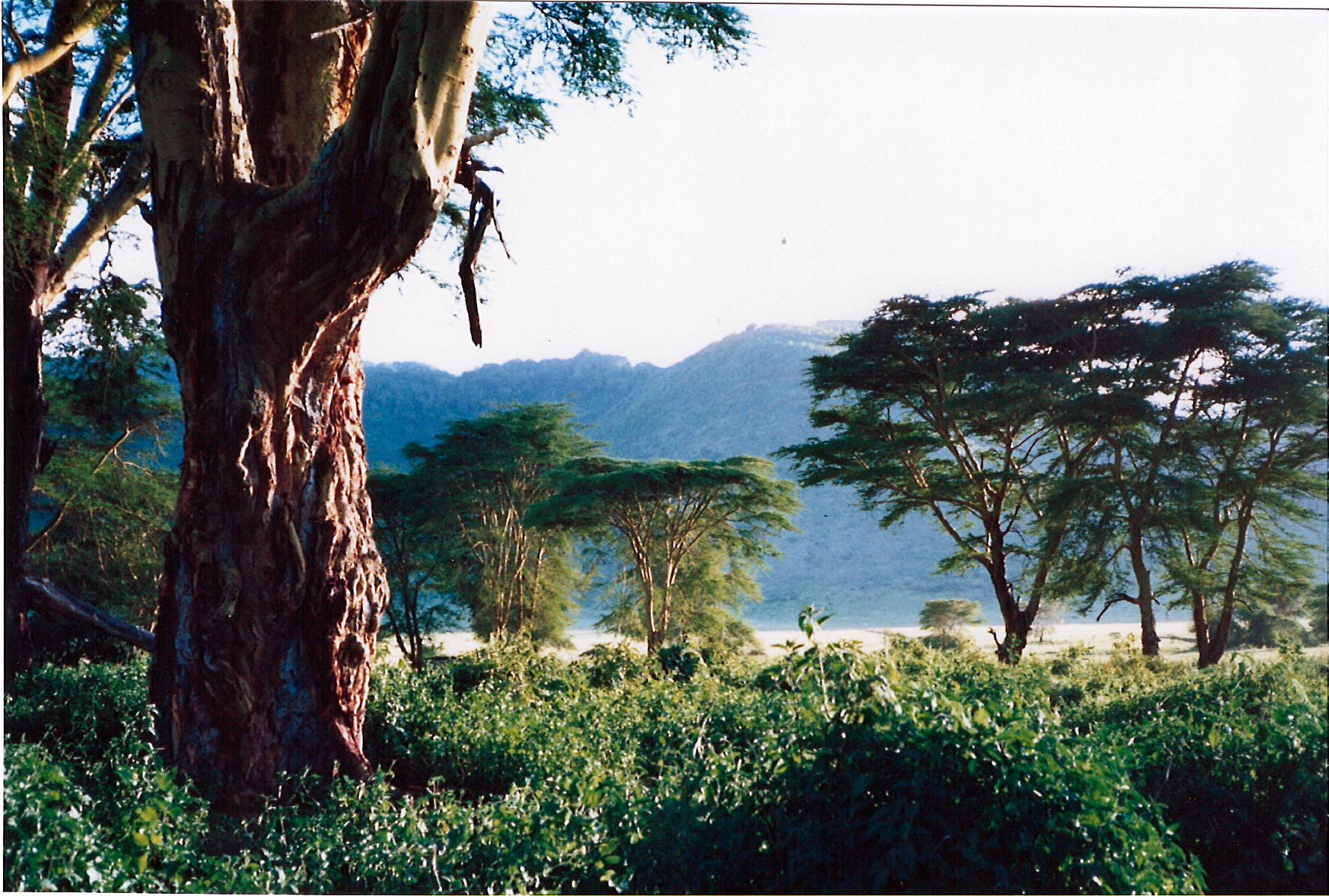 The big yellow fever trees (acacias) in the evening light
The big yellow fever trees (acacias) in the evening light
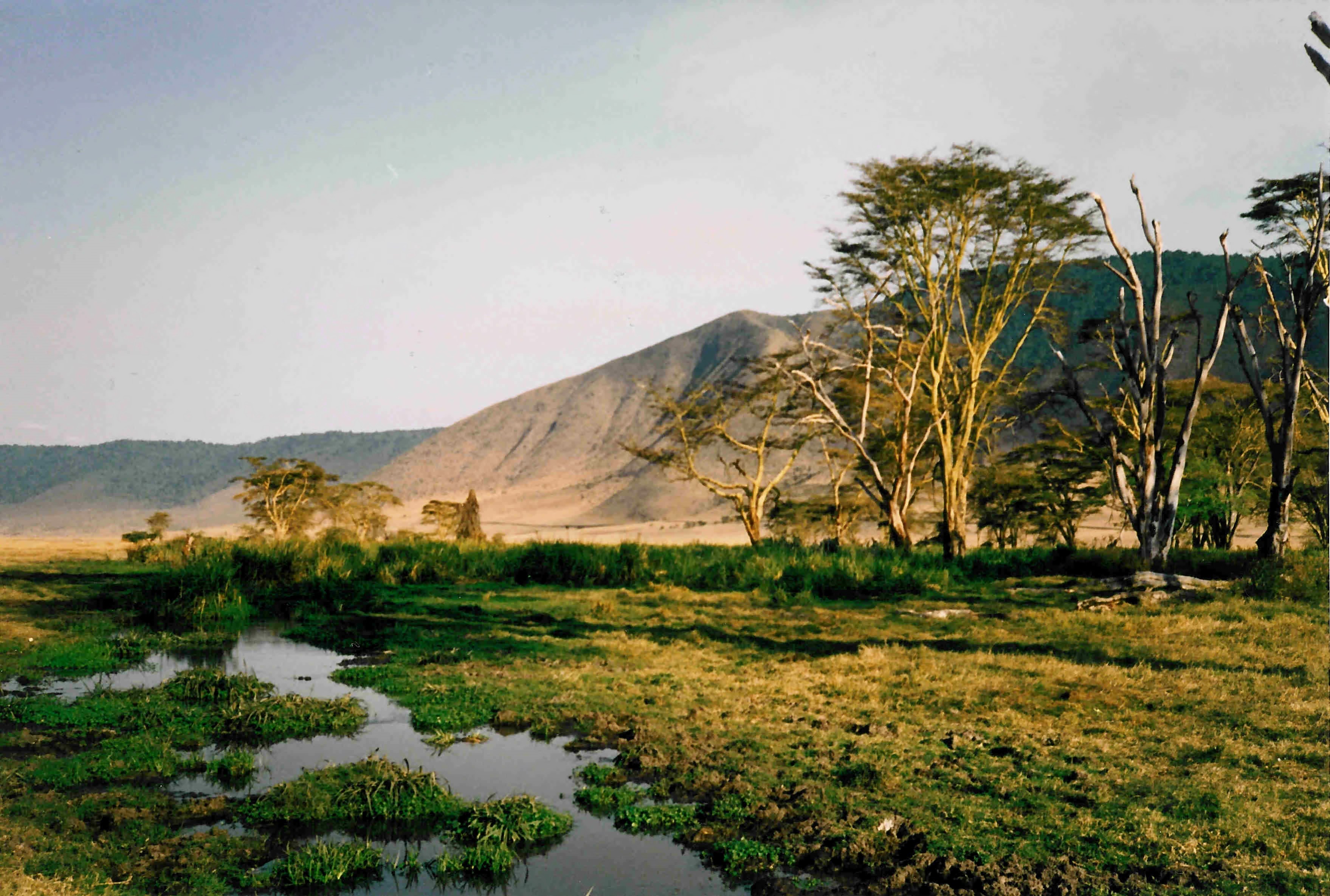 Yellow fever trees near a spring and crater’s rim
Yellow fever trees near a spring and crater’s rim
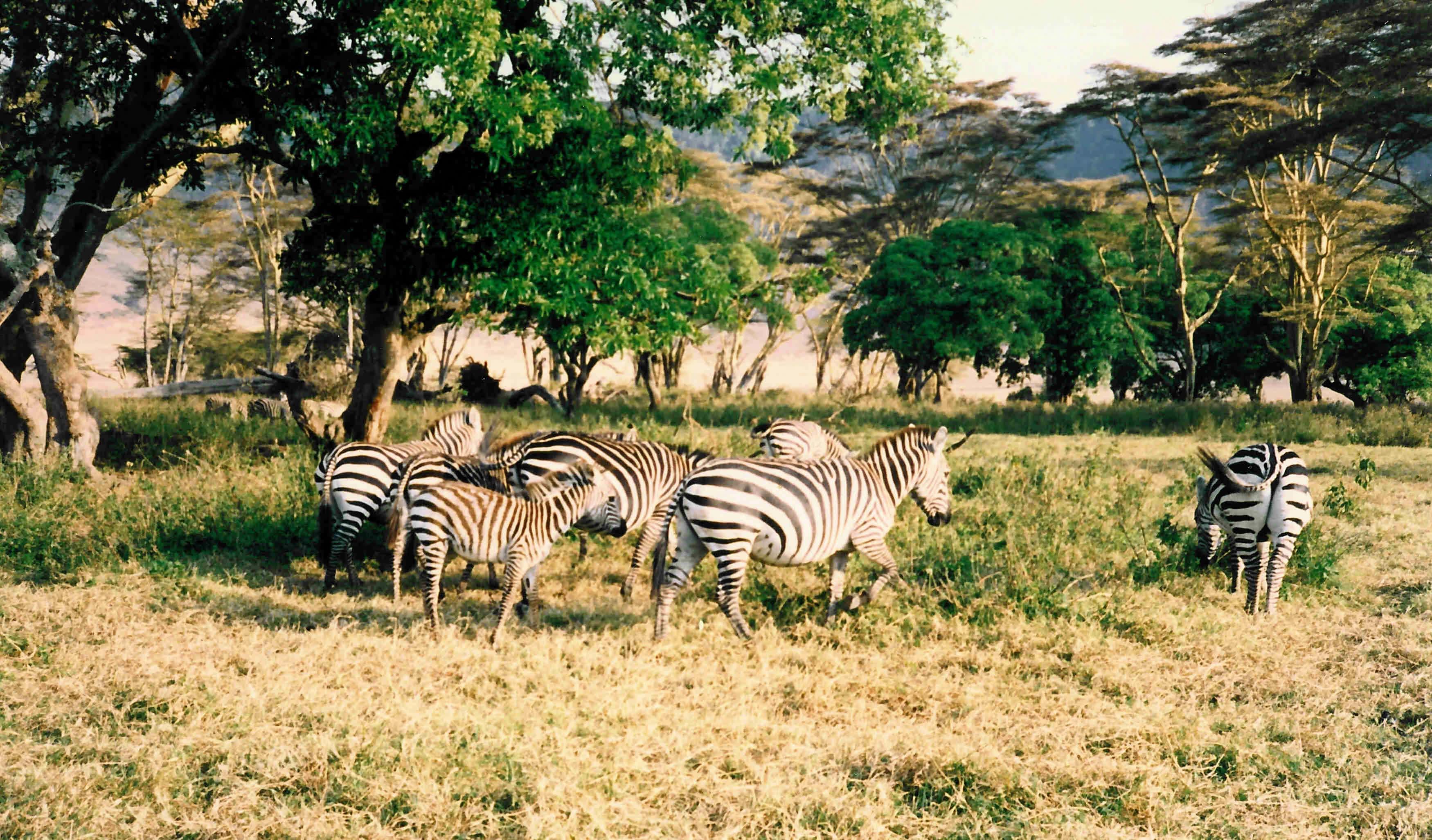 Zebras grazing the abundant grass near the tree
Zebras grazing the abundant grass near the tree
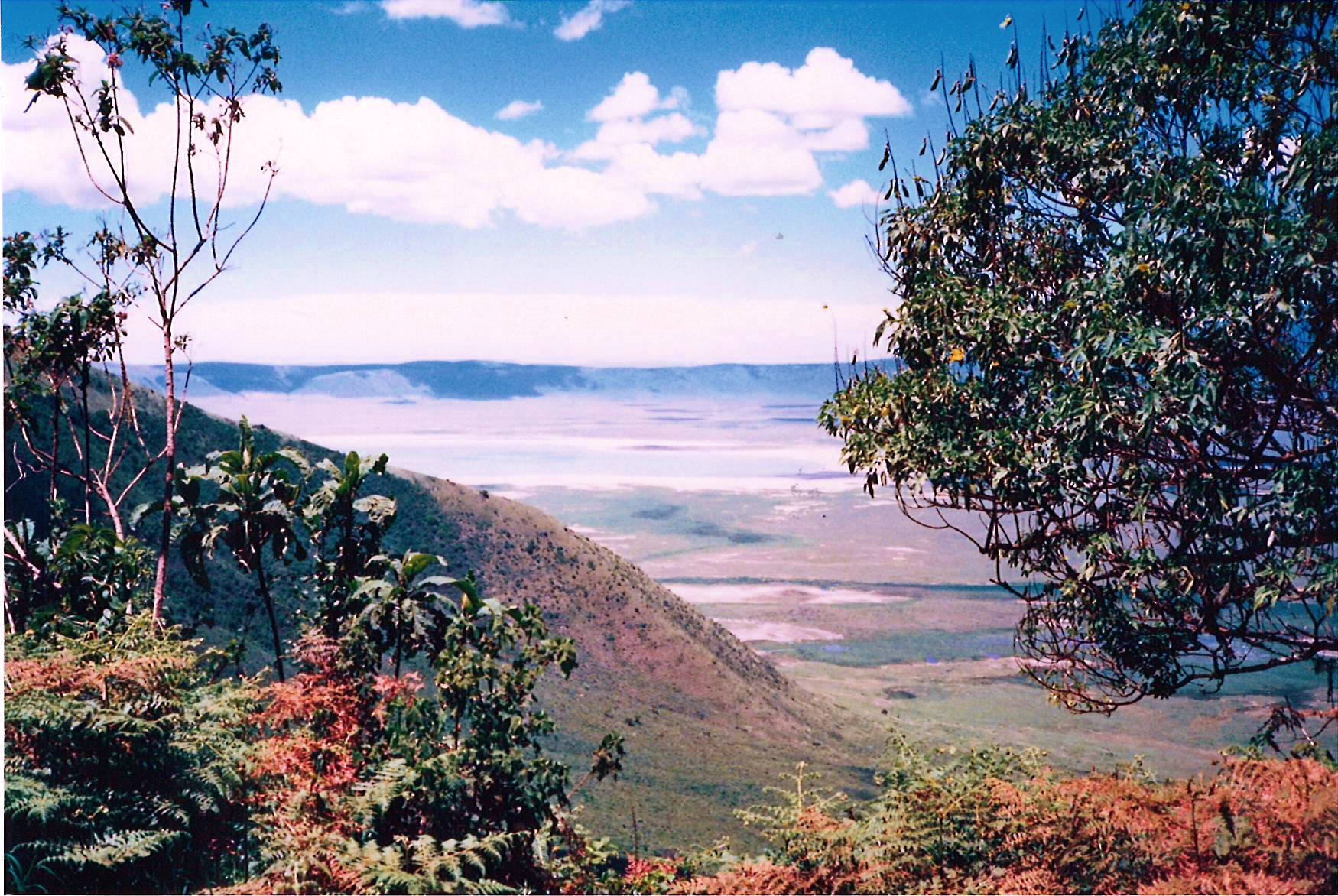 A mythical view climbing up the rim of the crater – much faded picture alas
A mythical view climbing up the rim of the crater – much faded picture alas
We reached the garage where we had to collect the tyres at night, but now needed to also ask for repair of those leaf-springs! It was of course too late for any repair to be done, but the tyres were mended and after some discussion about prices, we went away with what they called a “good price” which they agreed to because we had picked up some words –essentially numbers– of their excellent Tanzanian Kiswahili.
After that, in the dark, we drove pole-pole [10] to the campsite and started to prepare our meal. It was quite late again. But the ascari [11] had already prepared a really huge fire for the evening and we were better off than the day before with such a wonderful source of heat combined with the calories from our dinner. On top of everything, the wind finally dropped and we felt much warmer and more comfortable than the previous night.
Monday, 22nd of February – Such a tough transition – Getting out of bed roasting and boiling!
On that night, nobody froze, maybe somebody sweated, maybe somebody snored? But we didn’t really want to know about that. Soon after a glorious breakfast, 4WD and ScoutSpirit went to the garage and Khanga, X-Ray and I stayed at the campsite, cleaning and packing up. We also got slightly burnt while talking in the sun in our swimming suits at an altitude of 2,600 m! When 4WD and ScoutSpirit came back with the car repaired, we packed up both cars and left. It was too late to think about a way back through the Serengeti [12]. So we decided to go to Manyara for a game-drive and the night.
 At the campsite after breakfast..
At the campsite after breakfast..
We were still on the rim at around 2 PM. We had a particularly unpleasant picnic lunch there because we had chosen the spot quite badly. First of all, there were no trees to offer shelter, and the grass and bushes were high enough to hide the great view. Then, hundreds of biting flies invaded the place, a total nuisance! On top of that, the Land Rover got stuck trying to climb over the ditch towards the picnic spot. It was then pulled out by the Trooper (polite return for the help received in Shaba [13]).
After this not-so-brilliant rest we rushed down the slope towards the park gate. Just after the gate, as the forest ends, we found migratory European storks, impressive clouds of them, hundreds in the sky and hundreds on the ground, for a total estimated at about 3 thousand! We felt a deep emotion gazing at this extraordinary meeting and thought that some of them might even come not far from our home back in Europe!
We reached Manyara at 5 PM, just in time for the traditional mate! Once out of the car, we were very surprised by the heat. We went for information and for the usual entrance and camping fees and then we rushed for a late game drive, hoping secretly for a view of some of those lions hanging from the trees, the speciality of Manyara National Park [15)! But none were to be seen. Instead we saw lots of baboons in the forest and then water birds and hippos near the river. Not much more to see except a jackal, a few zebras and antelopes. This seemed rather dull after the diversity and abundance of wildlife in the crater, but the sight of hippos in the shallow pool was tremendous. As usual we had to hurry out of the Park as it was closing down. Again the mild yellow light of evening was so enjoyable…
 On the dirt road towards Manyara…
On the dirt road towards Manyara…
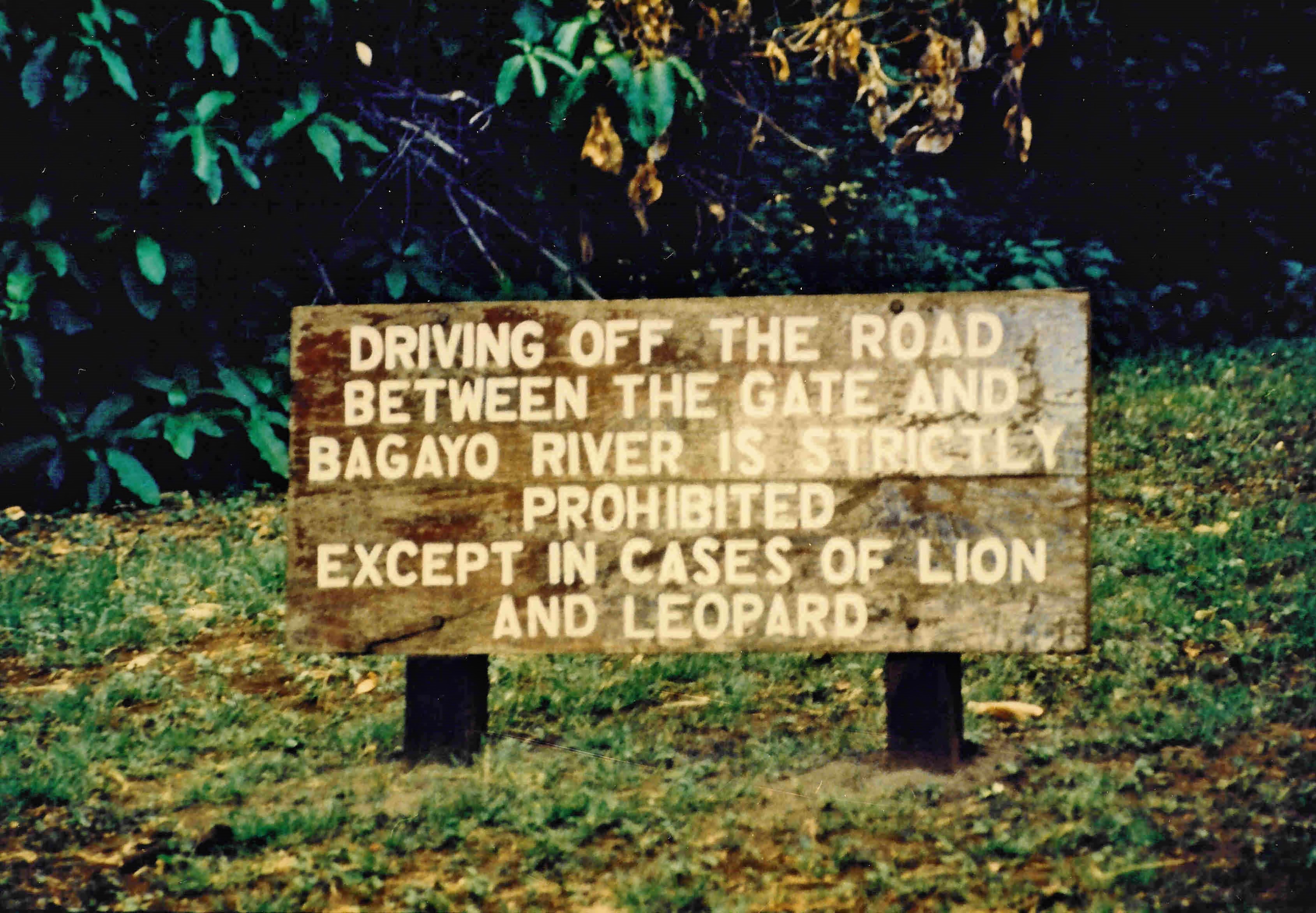 Important sign board to read at our arrival… (4WD’s picture)
Important sign board to read at our arrival… (4WD’s picture)
 Manyara Springs, near the entrance…
Manyara Springs, near the entrance…
 PinkShade and X-ray watching the hippos…
PinkShade and X-ray watching the hippos…
 At dusk at Hippo Pool, so quiet!
At dusk at Hippo Pool, so quiet!
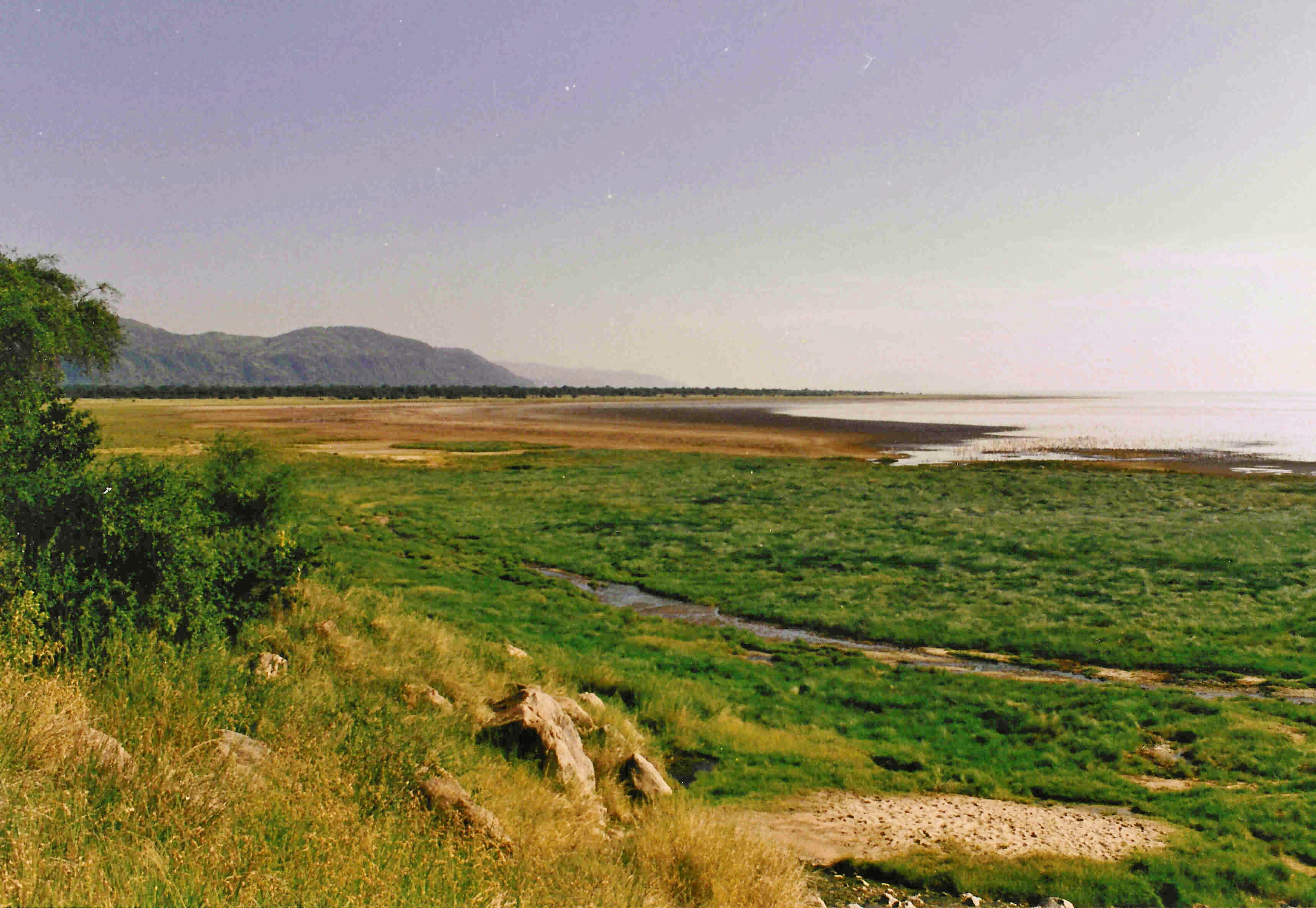 Manyara Lake with flamingoes in the far…
Manyara Lake with flamingoes in the far…
Baboons were occupying most of the campsite, so we had to choose within what was left! Again the meal arrived somehow late, but everybody was happy and much refreshed by a cold shower. It didn’t take time before we were all feeling very hot again as the temperature was quite high. The heat put us in a sleepy mood and helped us to go to bed early.
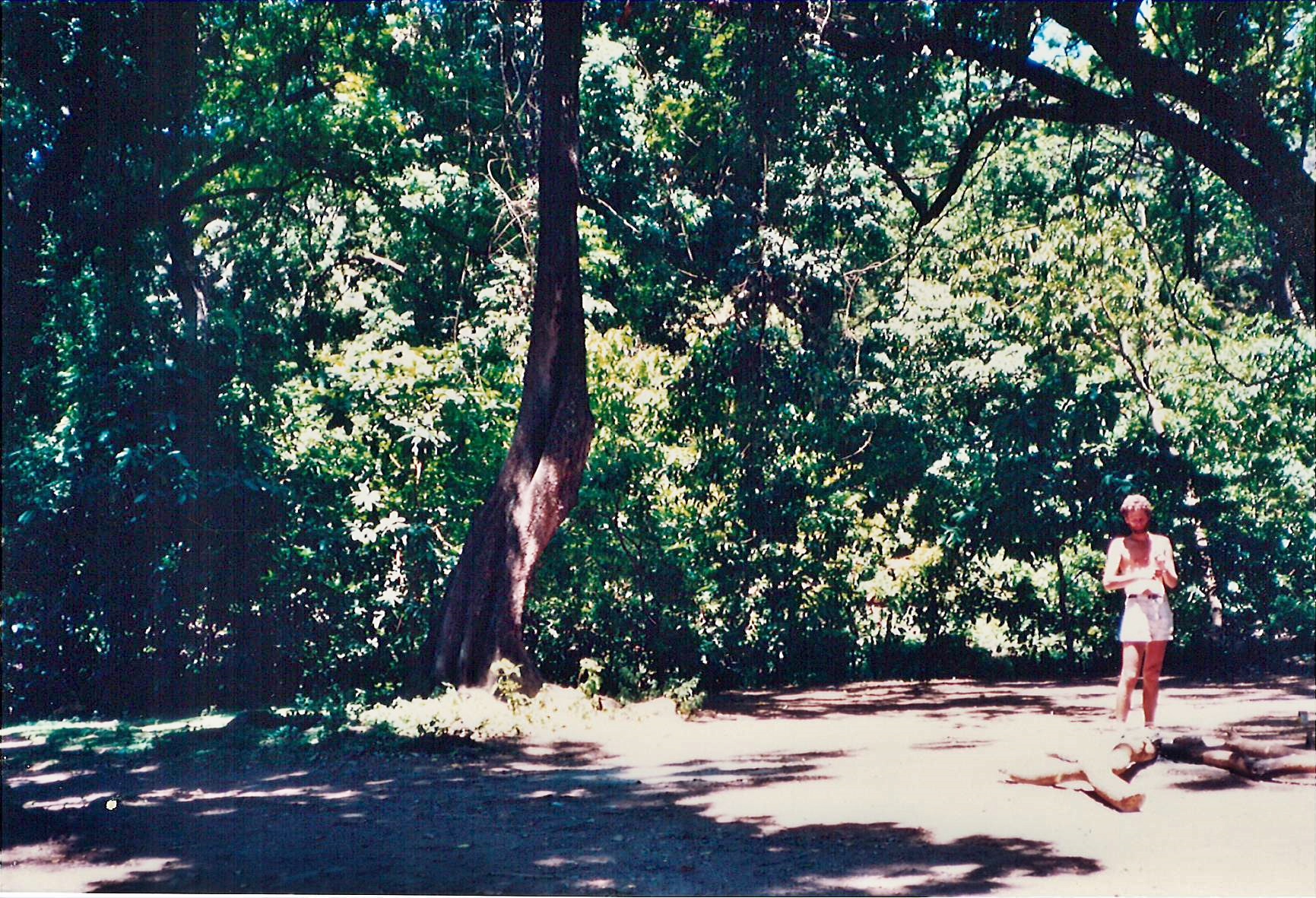 ScoutSpirit preparing the camp fire to cook our meal
ScoutSpirit preparing the camp fire to cook our meal
Tuesday, 23rd of February – If only it could never end – Getting back near the farewell!
The baboons seemed to quarrel all night and none of us had a good nights sleep! This may help you to understand why these safaris are so tiring. It is not the travelling on bumpy roads in the heat and dust, looking for the right track and avoiding the ditches, pools or rocks, or trying to stay in the middle of the road when it is slippery like black-cotton mud. It is not the buying, preparing, cooking, packing of food, water and other survival supplies or doing the washing up, not even the setting up of the tents and sleeping attire. It is simply and basically the lack of sleep! And you would think, when people say they haven’t slept, that it was because of some exciting events or noises, the sight of lion’s footprints around their tents or the roaring of them in the neighbourhood or the belly rumbling of an elephant nearby. But you never ever think, nobody dares to say it as it is, that it is because of cold weather, hot weather, shouting baboons or persistent mosquitoes. Yes, these are the most common reasons for sleepless nights in the bush! Remember this clearly.
Well, anyhow, in spite of that short night, we woke up as early as possible in order to go and look for those famous lions and enjoy the dawn. We covered the entire length of the Park, up to Maji moto [16], number two. We saw nothing special except an unusual sunrise on the mountain’s slope on our right hand-side. Around us, there were very big baobabs, herds of gazelles, many giraffe and even some hippos out of the water grazing peacefully. It looked like the beginning of the world, a magnificent and quiet world, just before the baboons and the men took their place in the evolution!
At the hot spring (Maji moto), a ground hornbill greeted us from a big rock and flew away noisily. It was 9 AM and we were sweating like hell. I guess that is why the place is called “hot springs” since there was, by that time, no water really springing there!
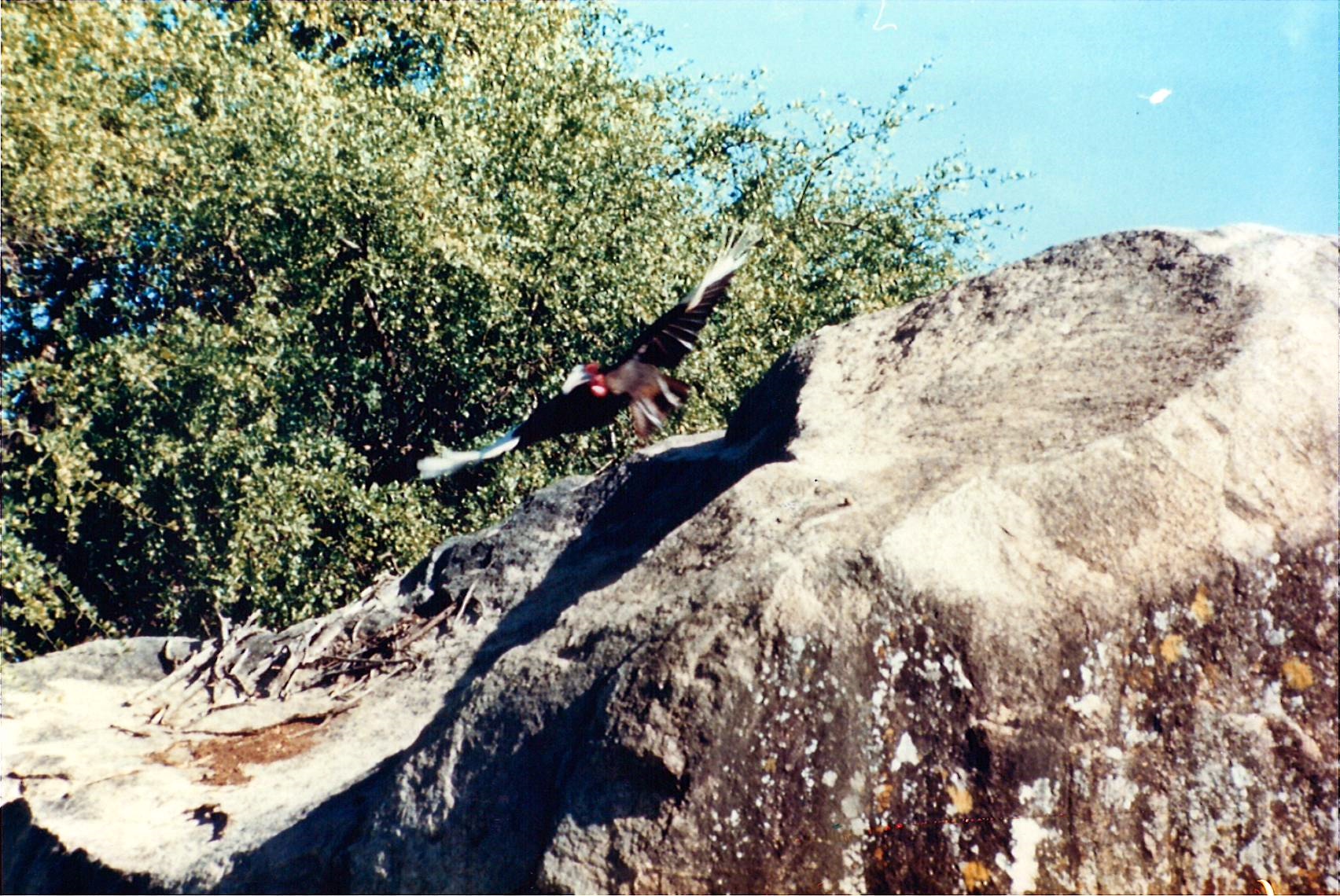 A ground hornbill taking off (4WD’s picture)
A ground hornbill taking off (4WD’s picture)
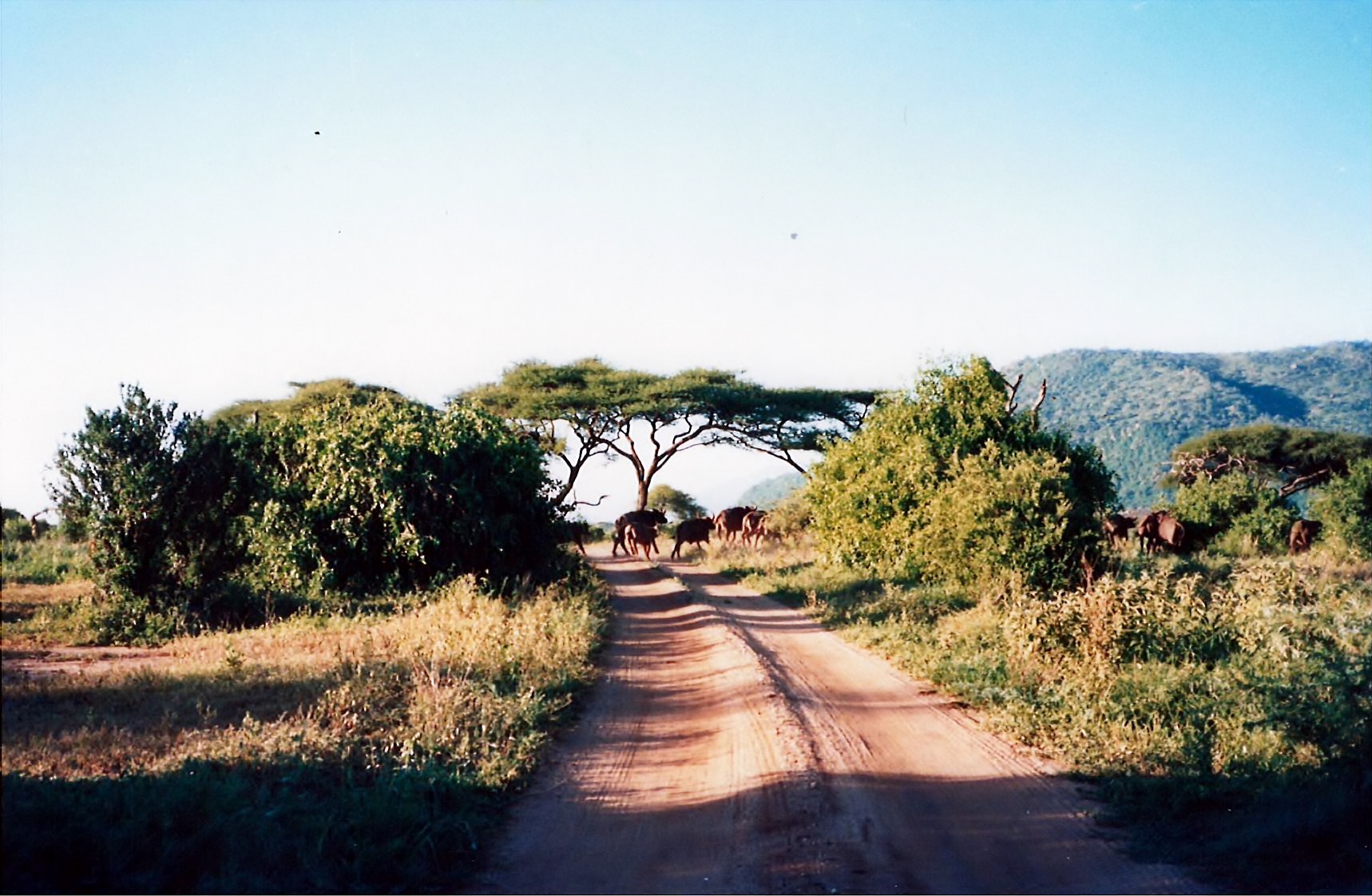 Buffalo!
Buffalo!
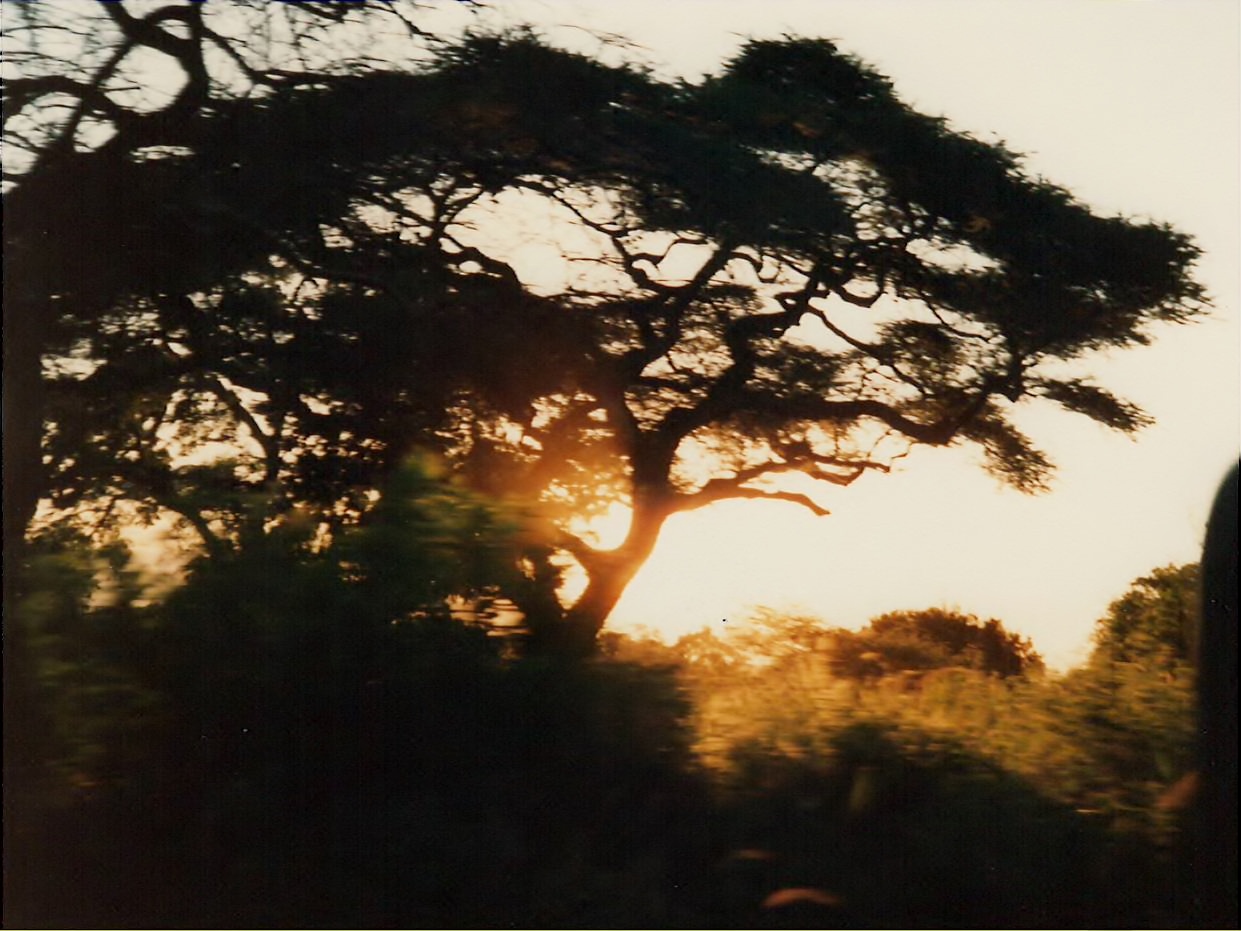 A beautiful African scene at sunset
A beautiful African scene at sunset
 A clear Mount Meru, appearing on our way back!
A clear Mount Meru, appearing on our way back!
Well, as we had to reach Nairobi on the same day, we quickly turned back towards the campsite for a big brunch. Yet it was a nostalgic meal as is every last moment before packing and leaving a nice place. We were interrupted in our nostalgic mood as we noticed that the baboons, probably wanting to show us disapproval for camping there, had jumped on our tents, and had opened one of our boxes and spread everything around with their dirty hands and feet. We really didn’t approve of their idea of using our tents as trampolines, especially our brand new one which looks now and forever “used”, much used! Near 11 AM we were all ready, the Land Rover had even been washed! So we moved off on our return journey.
This was such a clear day that we felt absolutely sorry to leave. We headed for Arusha where we hoped to acquire some meerschaum-pipes and khangas. [17] After some circuits around the town –roadworks still in progress, we arrived at the very place where the shops were. A man was selling raspberries, a treat that is not to be found everywhere! When we had enough of hanging around, losing the others, looking for them, finding them again, we took off for Namanga where we had to stop for the customs and police checks.
Once on the Kenyan side, we went for a drink and stayed until dark because we couldn’t bring ourselves to end this safari. We all knew that it was most probably the last safari of this kind together as 4WD and X-Ray would leave Kenya for Ethiopia very soon. But ScoutSpirit and PinkShade planned to go and visit them there [18]. Anyway, the prospect of not living in the same country anymore was a bit hard to overcome. That is how we ended up in the Maharajah’s restaurant on Muindi Mbingu Street, in Nairobi, hungry and speechless. But despite our continuous efforts to appear cheerful, we were all half-asleep over our excellent dishes. We were sure that that night we would fall asleep very fast, and baboons could have danced on our bellies, or shouted in our ears, none of us would have noticed them.
THE END
PinkShade
[1] 4WD (four-wheel drive): as he can make his way through everywhere and possibly through every situation. 4WD is an ancient nickname of the well-known today’s Bushsnob!
[2] X-ray: as she has a very accurate eyesight and the ability to spot before anybody any living creature for miles around in the bush!
[3] ScoutSpirit: as he is so calm and well organized that you could always count on him to provide what you did not bring or to have some spare place in his boot to host your things even If very heavily loaded!
[4] PinkShade: as she used to wear particular sunglasses that makes you see everything pinkish and also because she tried very hard to see the positive things although sometimes very anxious in that period of her life!
[5] Khanga: as she is very keen on this typical East African cloth, and passionate for the birds of the same name (guinea-fowls)!
[6] More information on Maasaï circumcision under “Upset Maasaï” by BushSnob, in this blog (link : https://bushsnob.com/2016/07/16/upset-maasai/)
[7] NCA: “the jewel in Ngorongoro’s crown is a deep, volcanic crater, the largest unflooded and unbroken caldera in the world. About 20 km across, 600m deep and 300 km2 in area, the Ngorongoro Crater is a breathtaking natural wonder (Wikipedia + NCA’s official website = http://www.ngorongorocrater.org/).
[8] Mate: see “Swiss-Uruguayan Eastern Safari Rally” by Pinkshade, in this blog (link : https://bushsnob.com/2014/09/24/swiss-uruguayan-easter-safari-rally-kenya-16th-to-20th-april-1987/)
[9] There were no cell-phones in those days. We had to guess what to do!
[10] Words in italic are Kiswahili terms that we adopted as we found them more expressive or poetical than ours. Pole-pole means slowly, cautiously.
[11] Ascari is a Kiswahili word for a security guard.
[12] And through “Olduvai Gorge”, an interesting archaeological and paleontological site where the famous Leakey family made important discoveries.
[13] See “Easter Safari Rally” by Pinkshade, in this blog (see above)
[14] Dudus are the equivalent of troublesome insects or pests in Kiswahili!
[15] MNP: “the Park is a “Man and Biosphere Conservation Area” since 1981 and consists of 330 km2 of arid land, forest, and a soda-lake which covers as much as 200 km2 of land during the wet season but is nearly non-existent during the dry season. Its name comes from a plant called Emanyara by the Maasai (Euphorbia tirucalli) used for hedges to protect the cattle” (Wikipedia + MNP’s website = http://www.tanzaniaparks.go.tz/).
[16] Maji moto literally means “hot water” and usually indicates some hot springs.
[17] A khanga is a typical East African cloth (150 cm wide by 110 cm long) made out of light and colourful fabric, with a border all around, a symbol in the middle and bearing a Kiswahili saying. A post on Pinkshade’s mother Khangas’ collection is being prepared on those beautiful pieces of East African culture.
[18] A future safari to Ethiopia, to be read soon in this blog, hopefully!





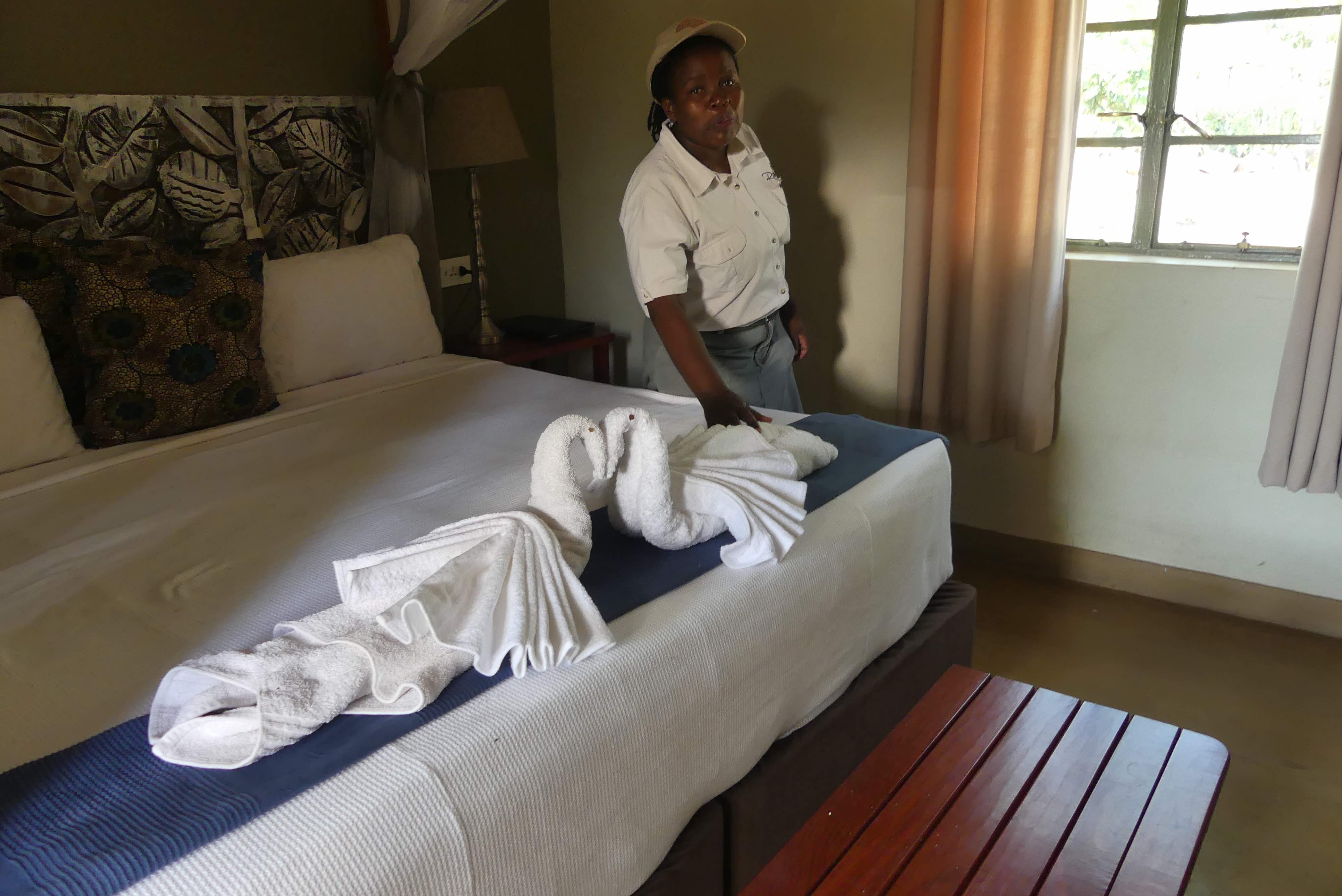
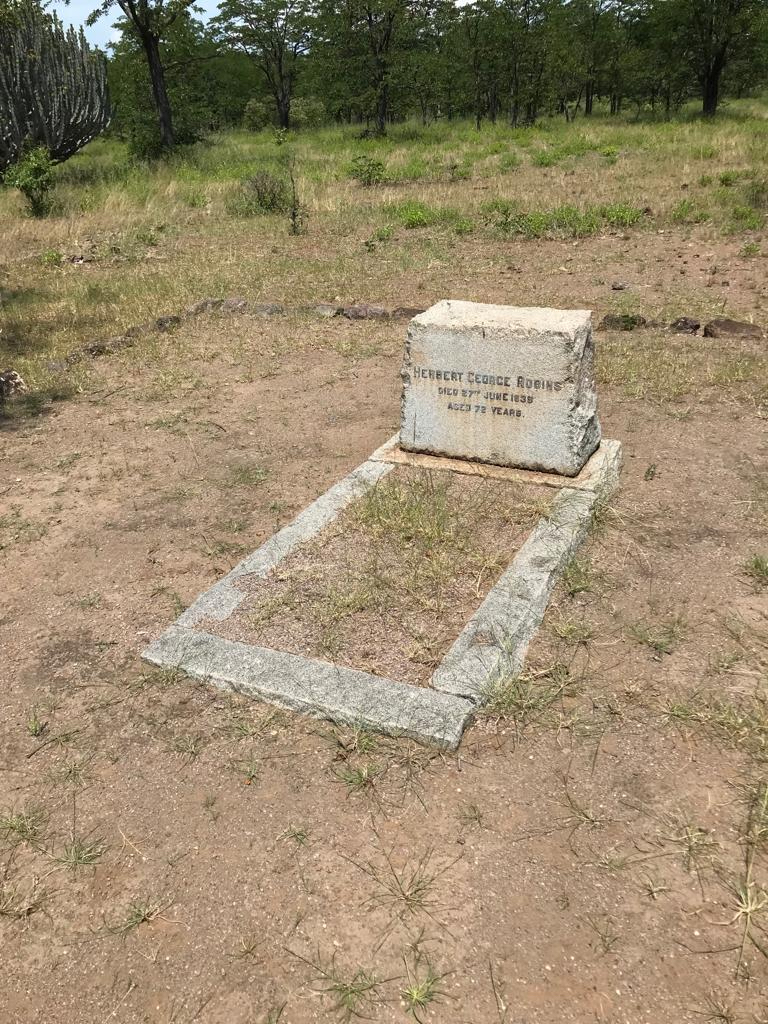

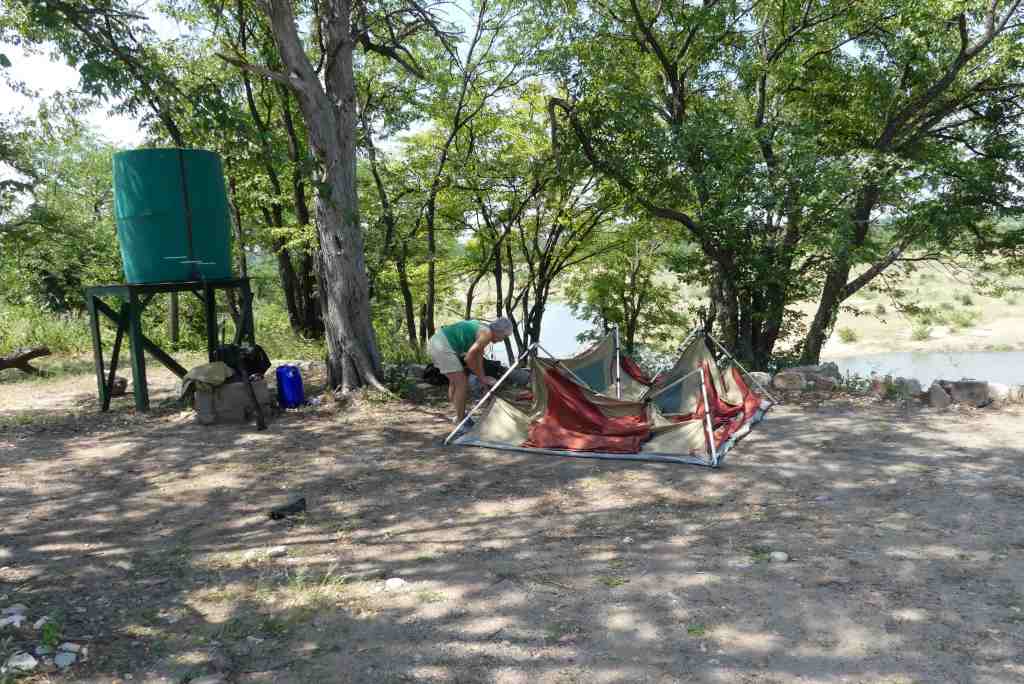
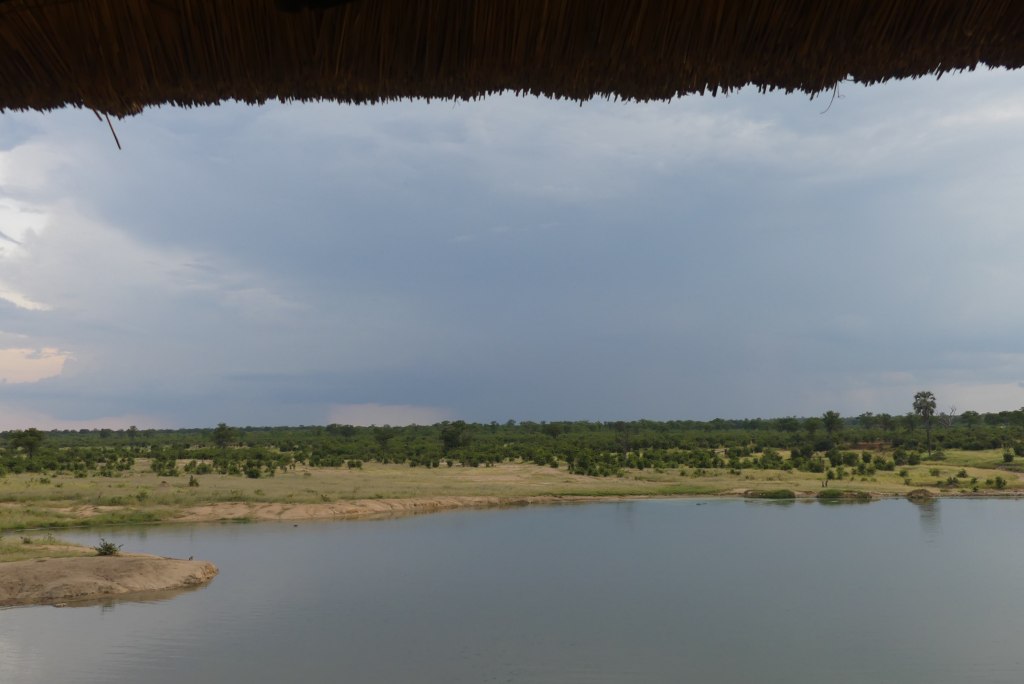
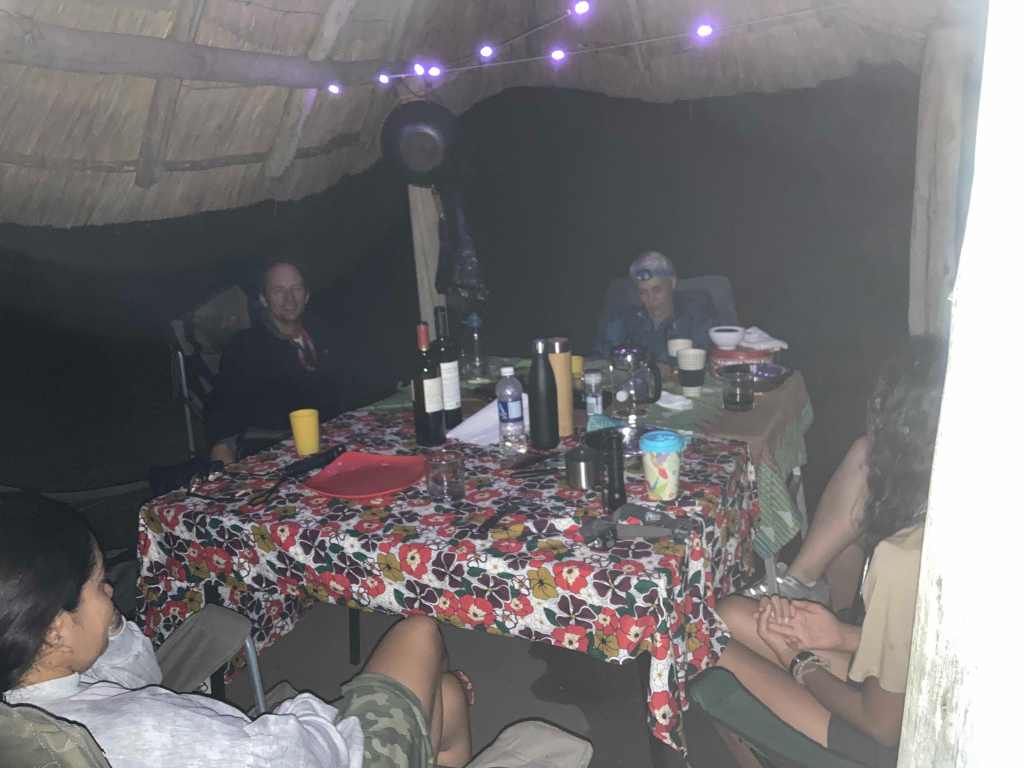

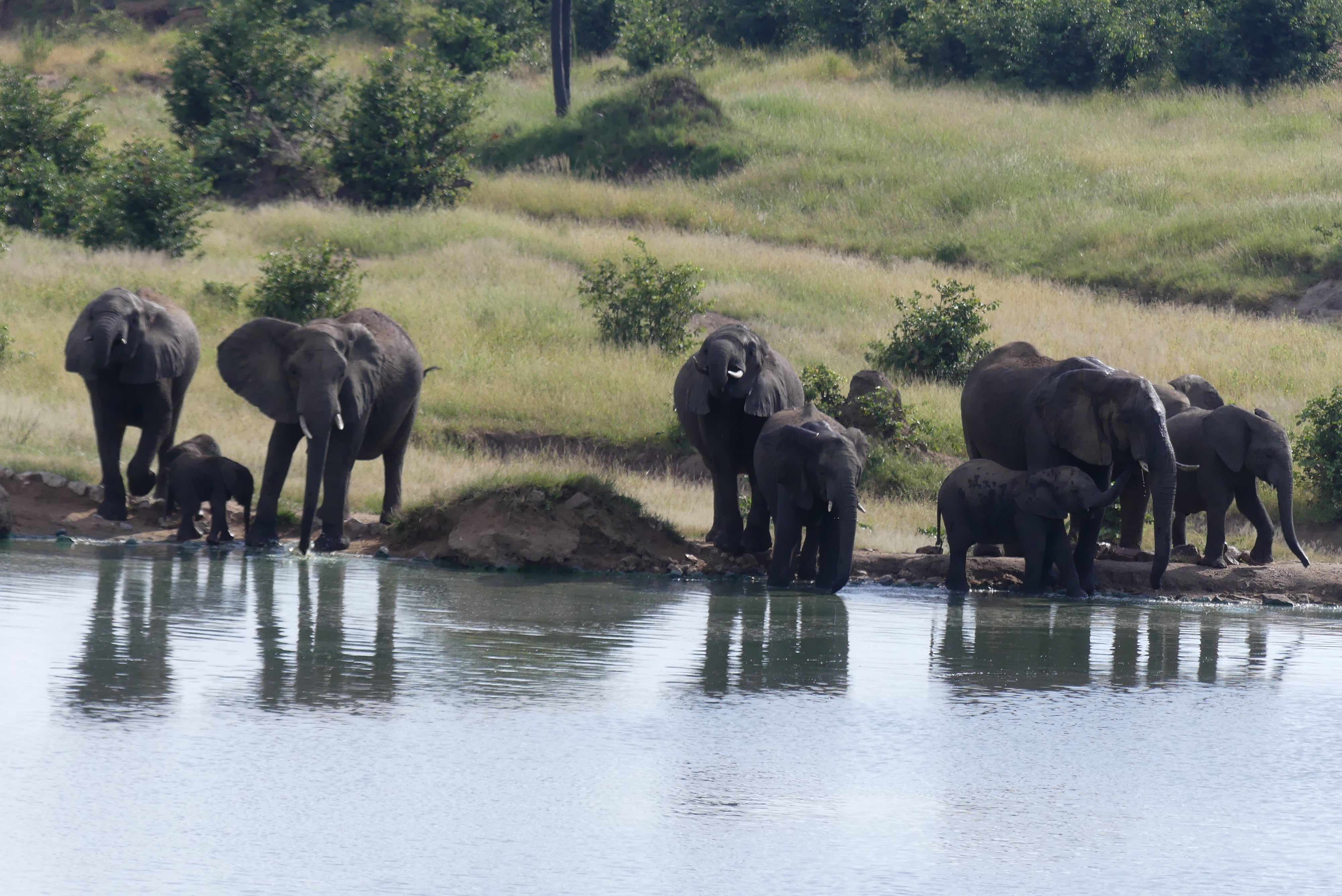
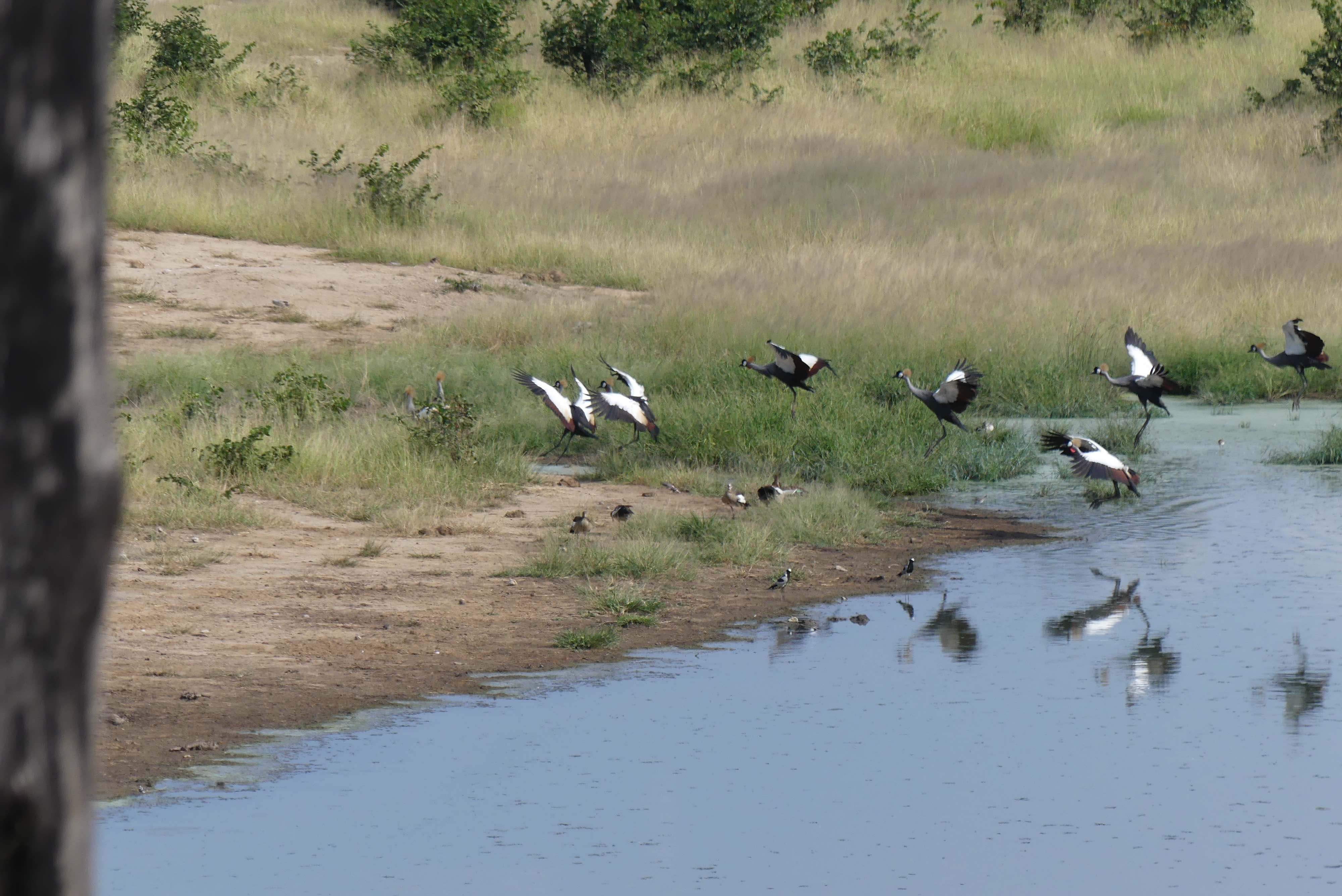


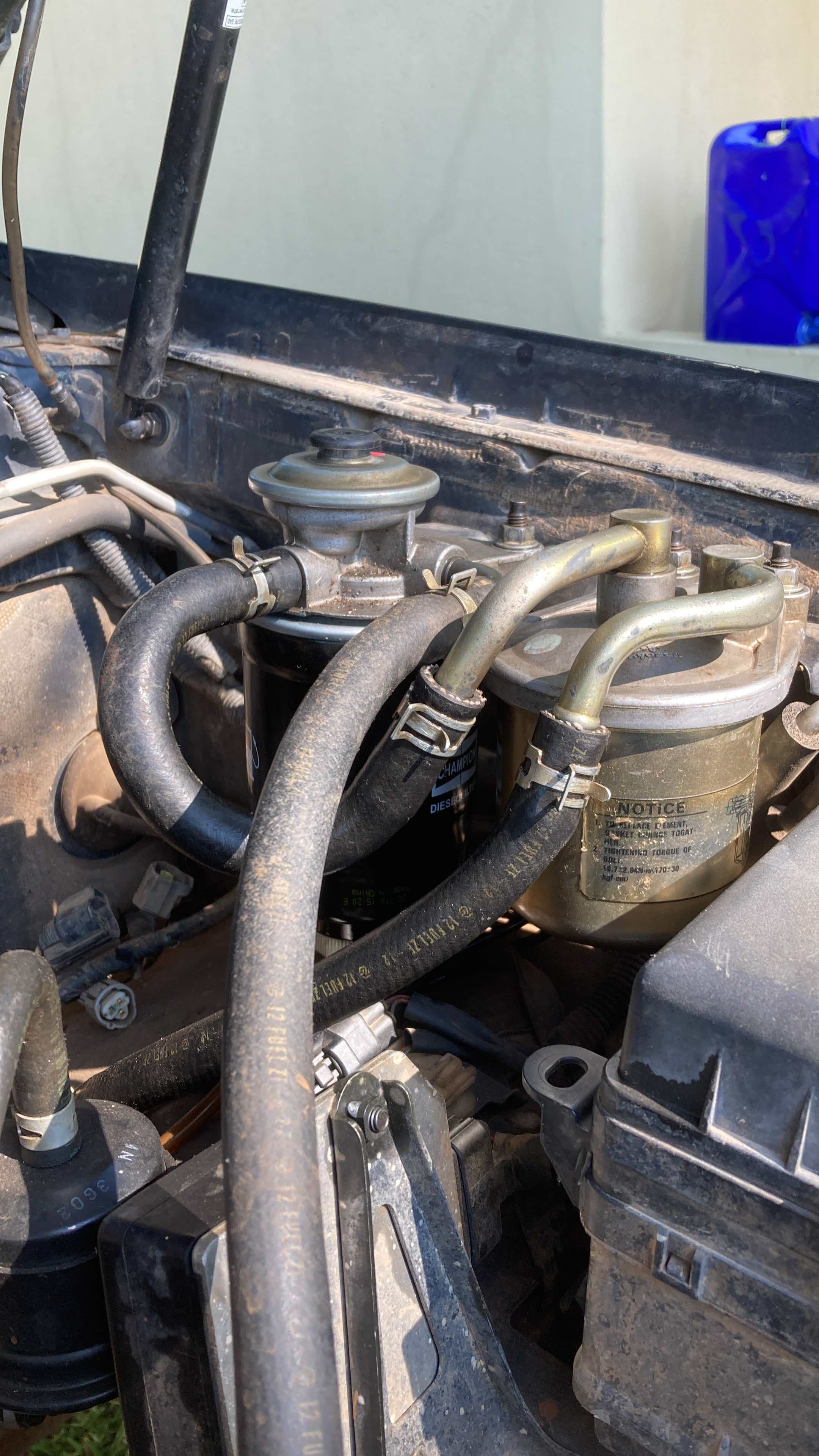





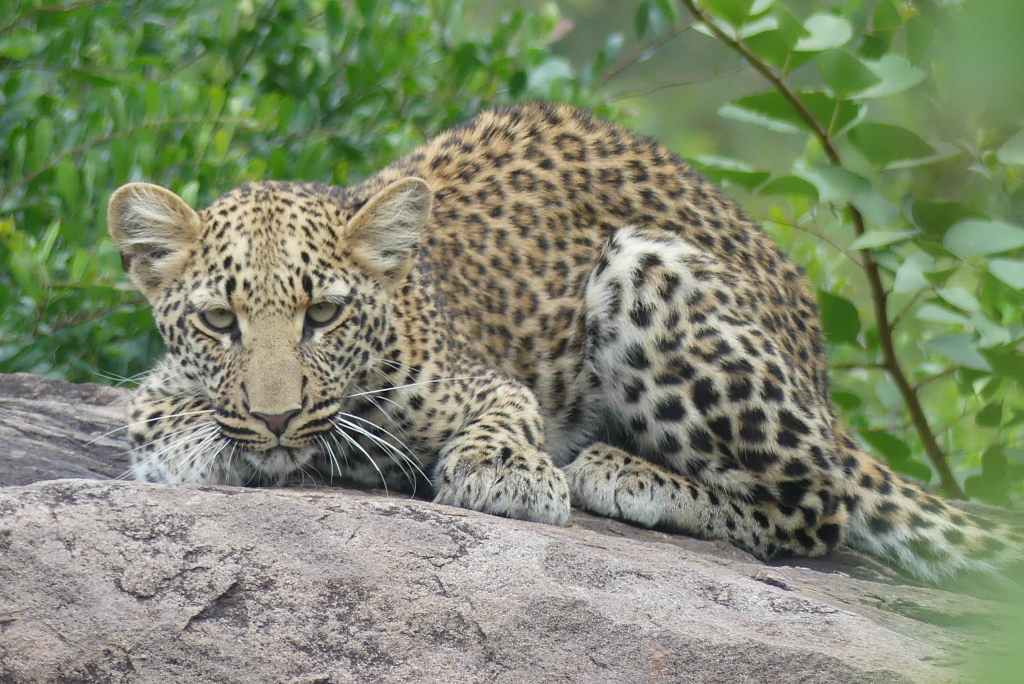


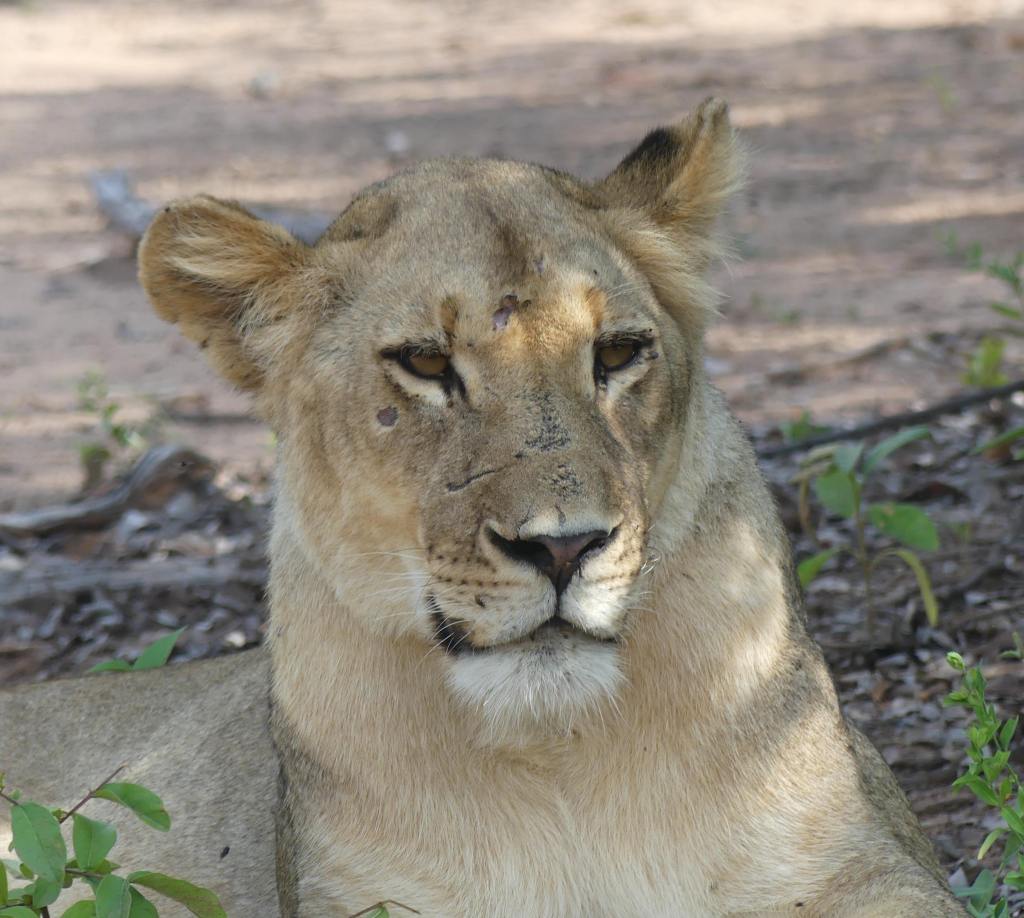

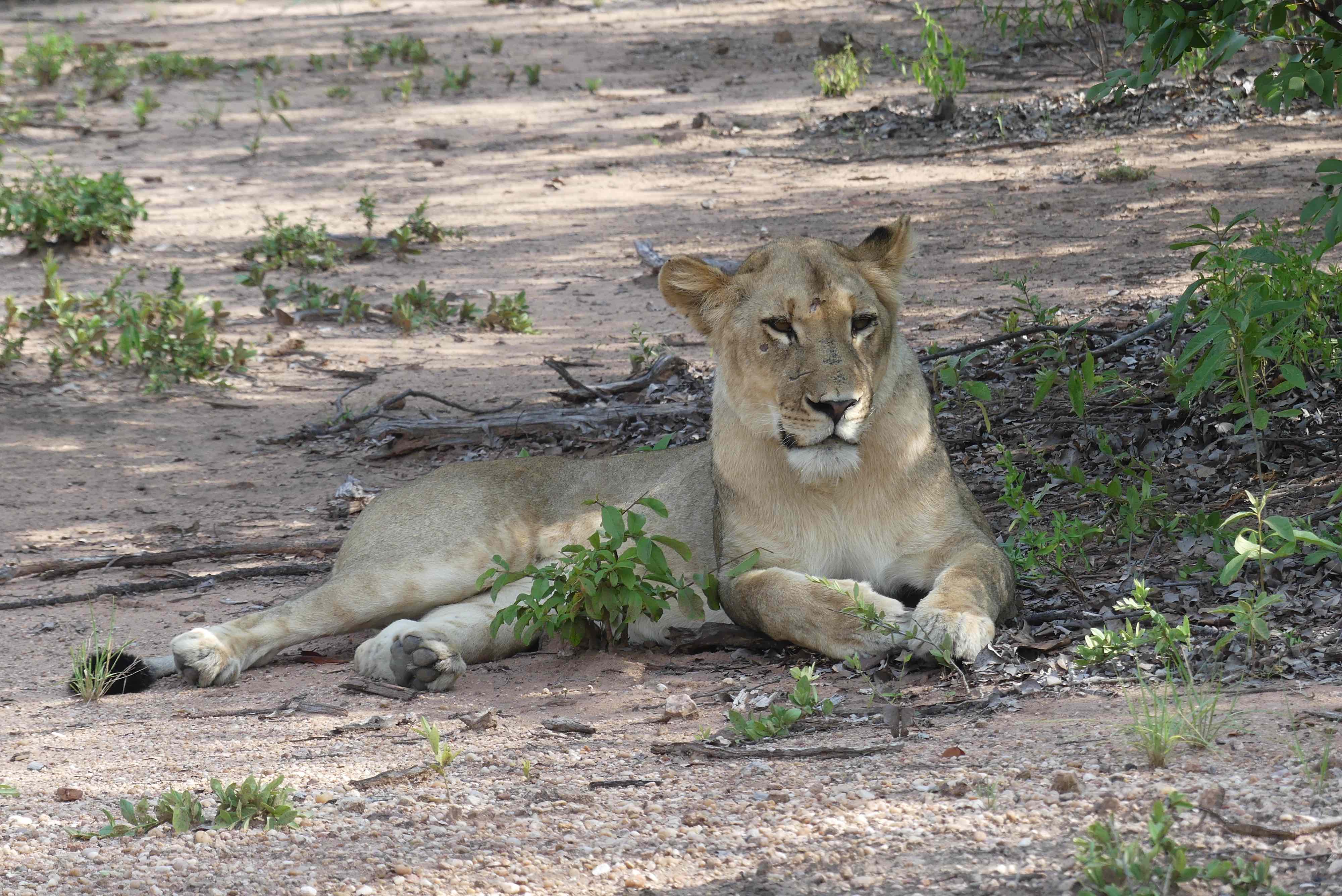
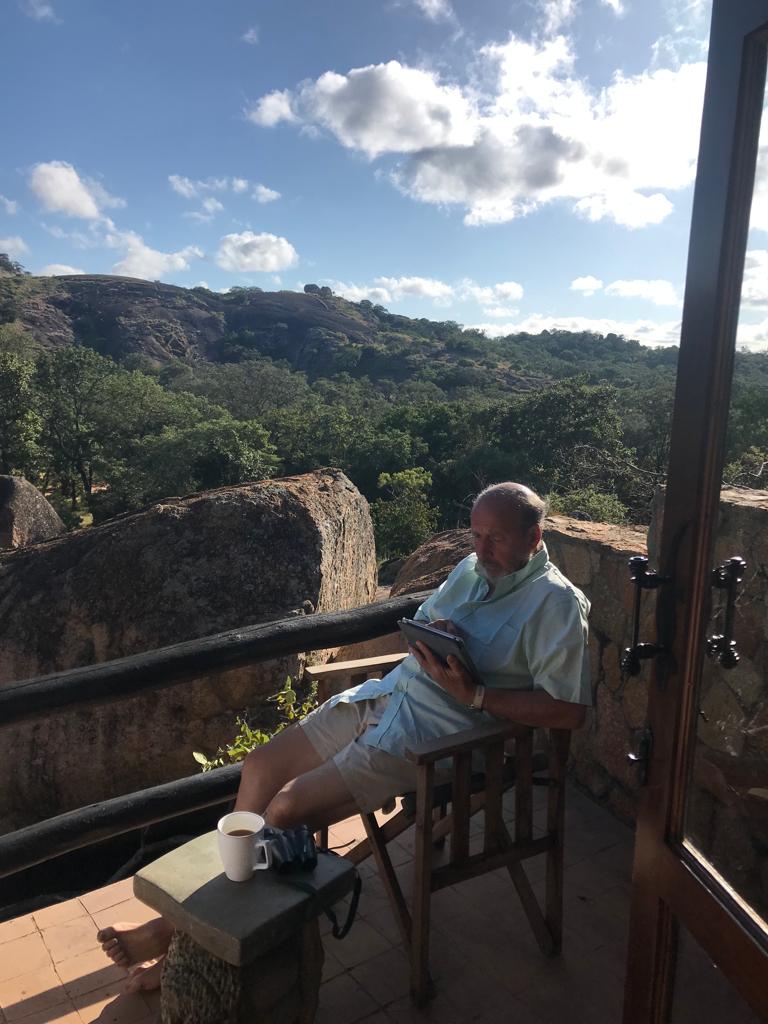



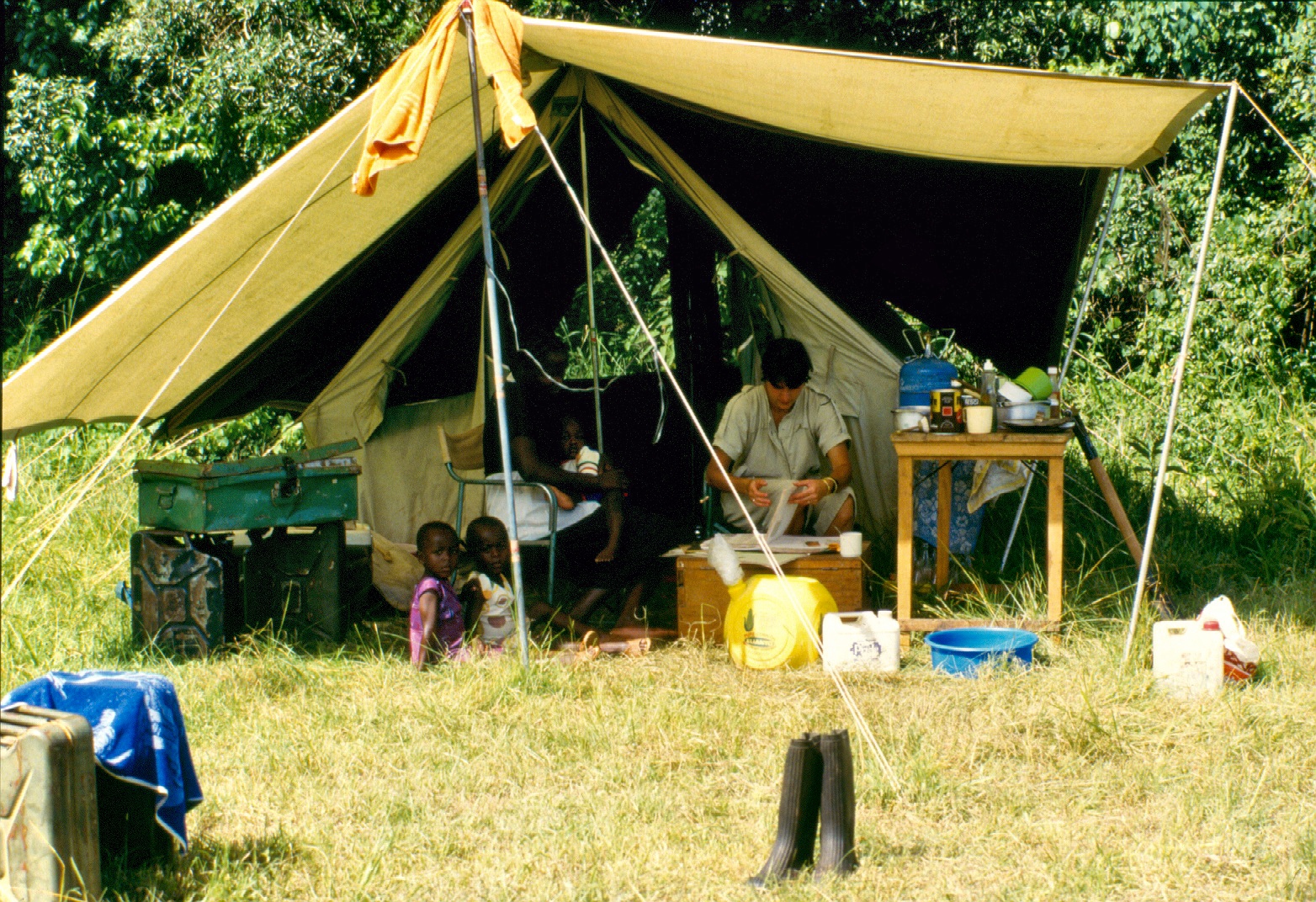
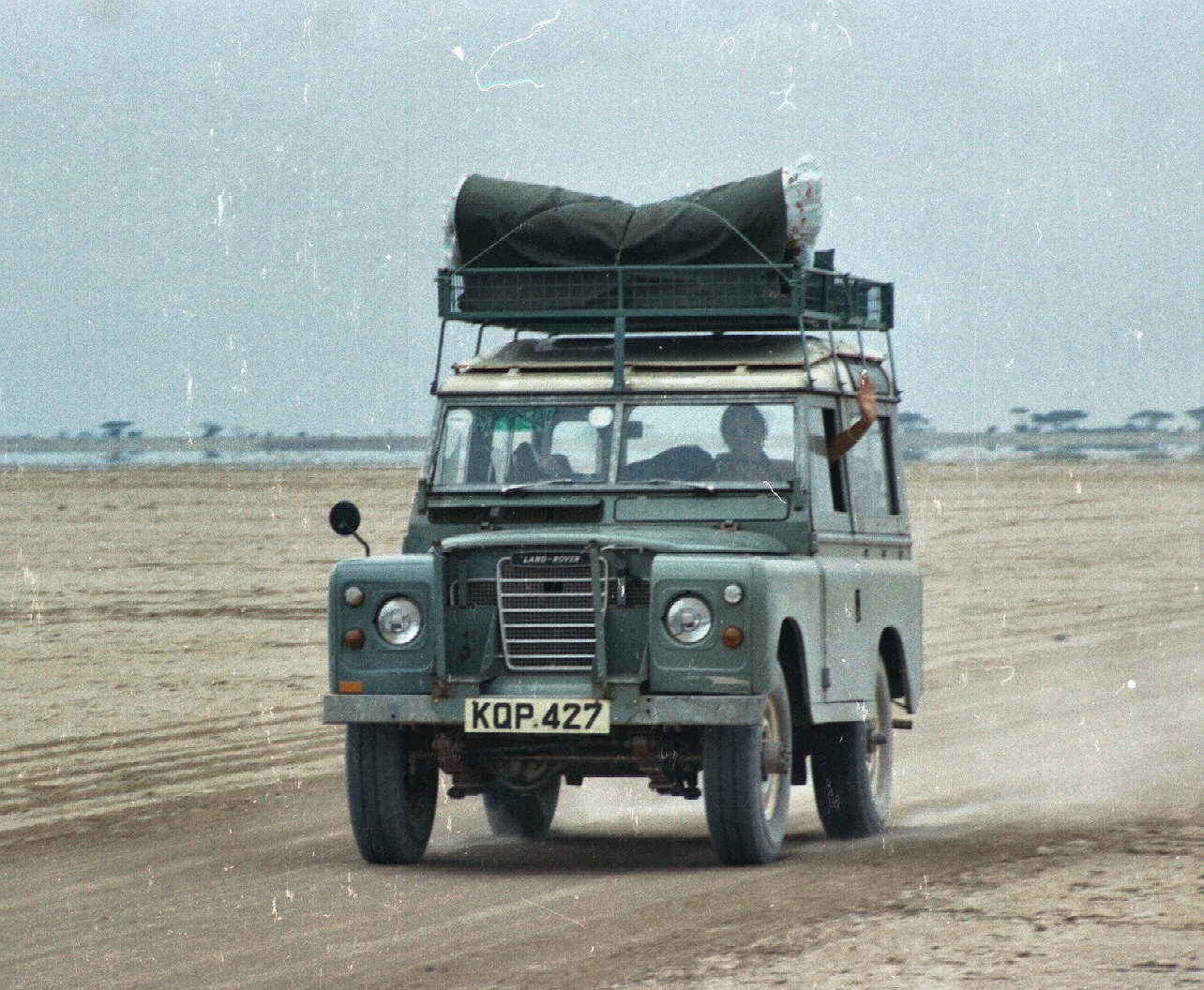




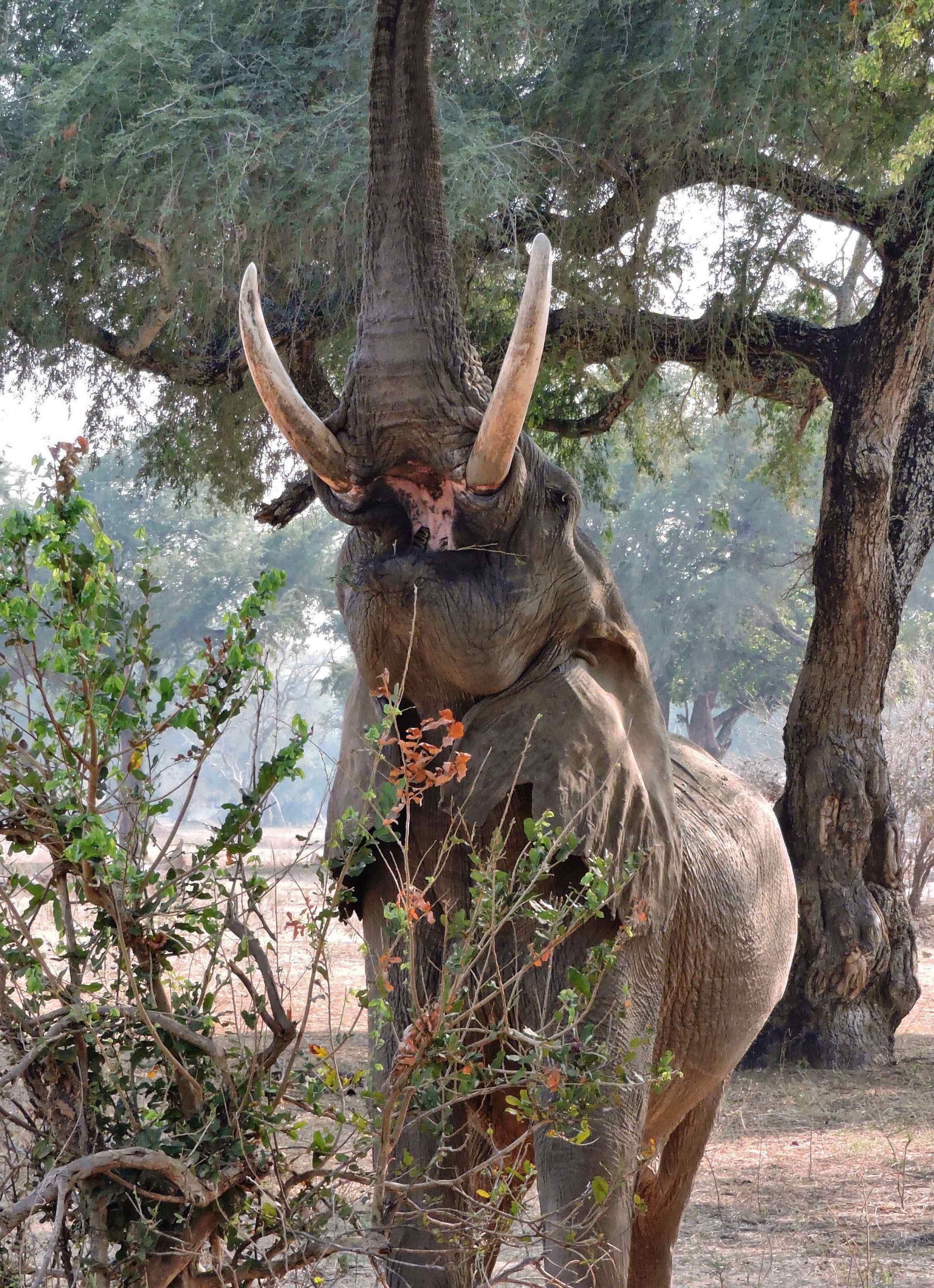
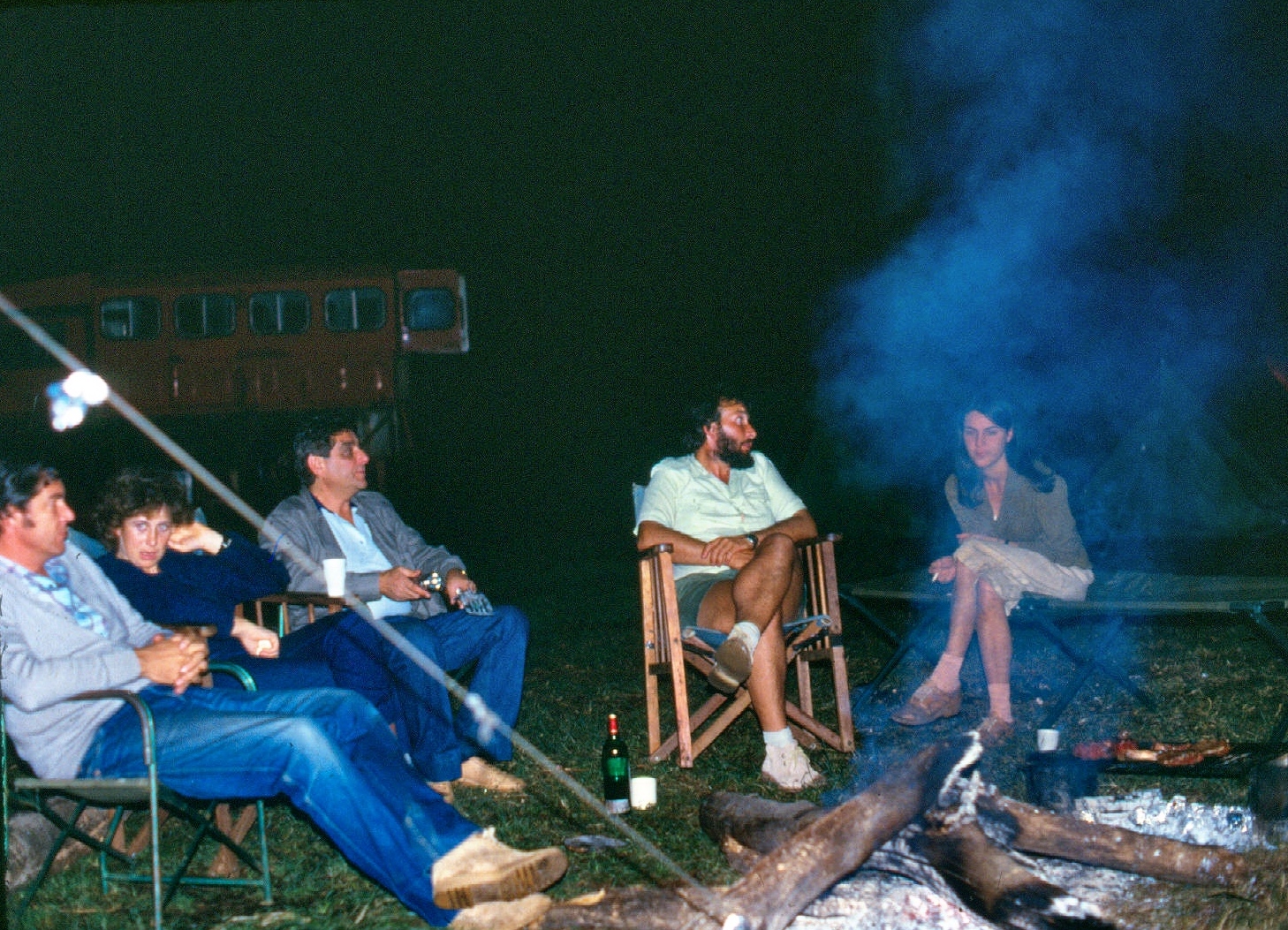
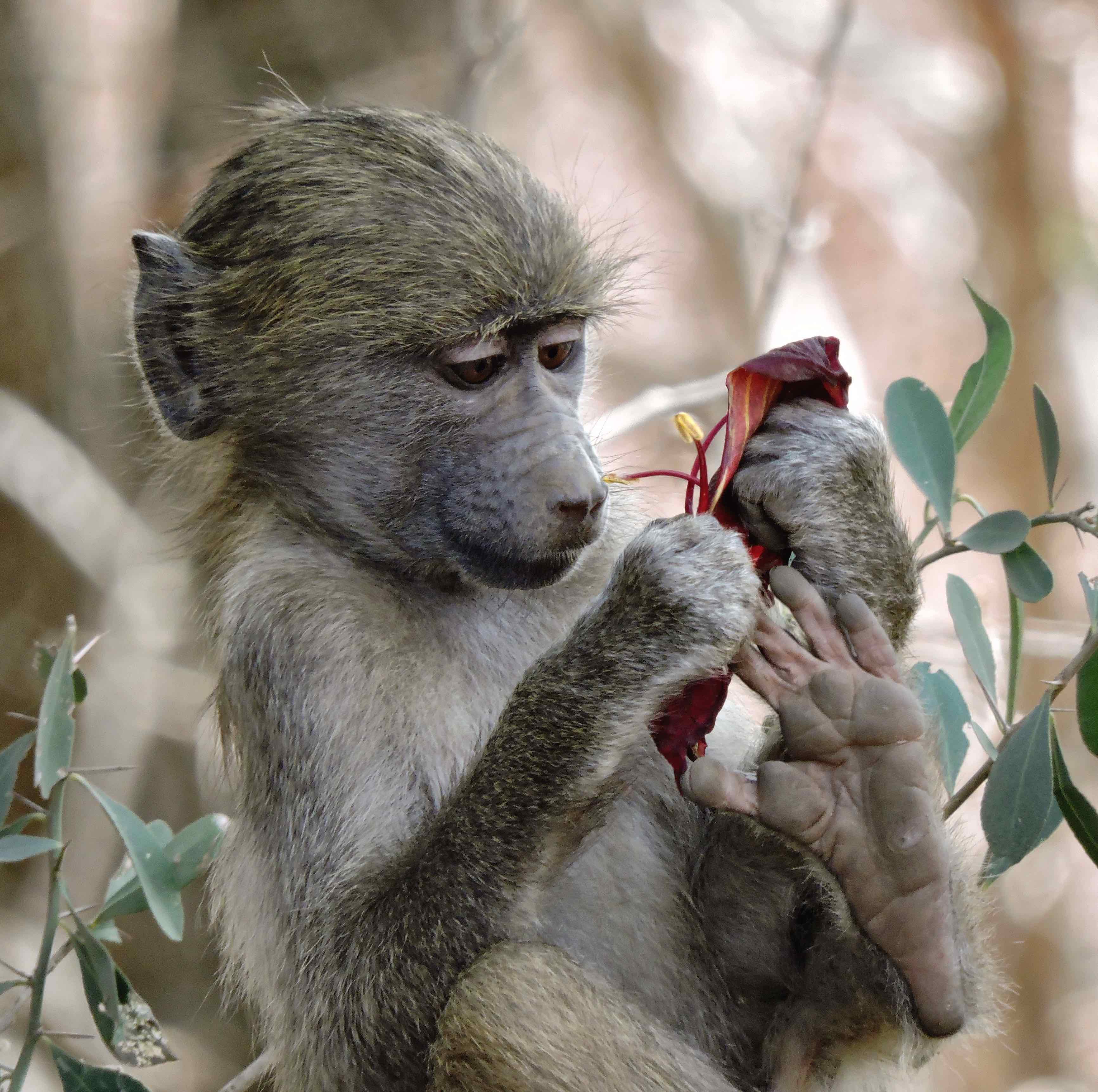










 Beautiful and promising wall-painting in a petrol station at the Kenya-Tanzania border!
Beautiful and promising wall-painting in a petrol station at the Kenya-Tanzania border! The team getting ready, early in the morning, around the Land Rover (PinkShade missing)
The team getting ready, early in the morning, around the Land Rover (PinkShade missing) A cultivated area on a wide plateau, before the entrance gate
A cultivated area on a wide plateau, before the entrance gate First view coming up the outer rim of the crater… almost at dusk
First view coming up the outer rim of the crater… almost at dusk The Simba campsite as we discovered it on the next morning…
The Simba campsite as we discovered it on the next morning… The pride of lions that 4WD and then Khanga spotted…
The pride of lions that 4WD and then Khanga spotted… Three black-maned lions lying by a small pond
Three black-maned lions lying by a small pond Yellow orchid found on the hill (4WD’s picture)
Yellow orchid found on the hill (4WD’s picture)
 The famous bustard, good friend of Khanga!
The famous bustard, good friend of Khanga! Egyptian geese feeding and resting near a pool
Egyptian geese feeding and resting near a pool The big yellow fever trees (acacias) in the evening light
The big yellow fever trees (acacias) in the evening light Yellow fever trees near a spring and crater’s rim
Yellow fever trees near a spring and crater’s rim Zebras grazing the abundant grass near the tree
Zebras grazing the abundant grass near the tree A mythical view climbing up the rim of the crater – much faded picture alas
A mythical view climbing up the rim of the crater – much faded picture alas At the campsite after breakfast..
At the campsite after breakfast..  On the dirt road towards Manyara…
On the dirt road towards Manyara… Important sign board to read at our arrival… (4WD’s picture)
Important sign board to read at our arrival… (4WD’s picture) Manyara Springs, near the entrance…
Manyara Springs, near the entrance… PinkShade and X-ray watching the hippos…
PinkShade and X-ray watching the hippos… At dusk at Hippo Pool, so quiet!
At dusk at Hippo Pool, so quiet! Manyara Lake with flamingoes in the far…
Manyara Lake with flamingoes in the far… ScoutSpirit preparing the camp fire to cook our meal
ScoutSpirit preparing the camp fire to cook our meal A ground hornbill taking off (4WD’s picture)
A ground hornbill taking off (4WD’s picture) Buffalo!
Buffalo! A beautiful African scene at sunset
A beautiful African scene at sunset A clear Mount Meru, appearing on our way back!
A clear Mount Meru, appearing on our way back!


